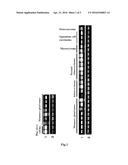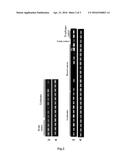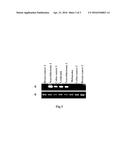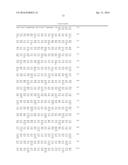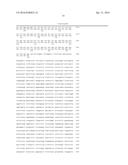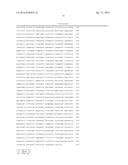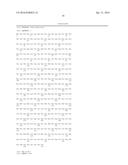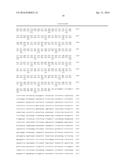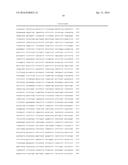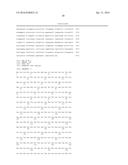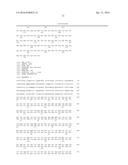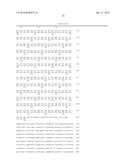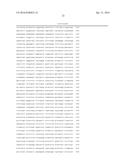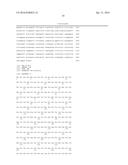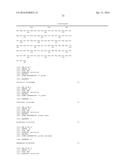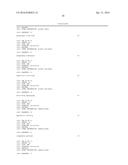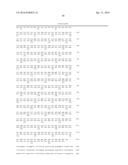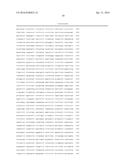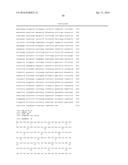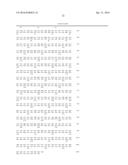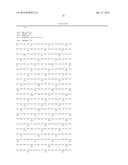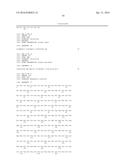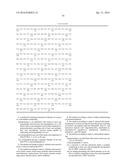Patent application title: IMMUNITY INDUCTION AGENT
Inventors:
Akira Kurihara (Kamakura-Shi, JP)
Fumiyoshi Okano (Kamakura-Shi, JP)
Fumiyoshi Okano (Kamakura-Shi, JP)
Assignees:
TORAY INDUSTRIES, INC.
IPC8 Class: AA61K3900FI
USPC Class:
424 852
Class name: Drug, bio-affecting and body treating compositions lymphokine interleukin
Publication date: 2016-04-21
Patent application number: 20160106823
Abstract:
Provided is a method for inducing immunity for therapy of a cancer(s).
The method includes the step of administering to an individual with
cancer at least one polypeptide selected from the polypeptides (a) or (b)
below, and/or a recombinant vector(s) that comprise(s) a
polynucleotide(s) encoding the at least one polypeptide, the recombinant
vector(s) being capable of expressing the polypeptide(s) in vivo: (a) a
polypeptide in any one of the amino acid sequences of SEQ ID NOs: 2, 4,
22, or 24; and (b) a polypeptide having a sequence identity of not less
than 95% to the polypeptide (a). Further, an in vitro method for
preparing an antigen-presenting cell is provided. The method includes the
step of contacting the antigen-presenting cell with the at least one
polypeptide selected from: (a) a polypeptide in any one of the amino acid
sequences of SEQ ID NOs: 2, 4, 22, or 24; and (b) a polypeptide having a
sequence identity of not less than 95% to the polypeptide (a).Claims:
1. A method for inducing immunity for therapy of a cancer(s), said method
comprising: administering to an individual with cancer at least one
polypeptide selected from the polypeptides (a) or (b) below, and/or a
recombinant vector(s) that comprise(s) a polynucleotide(s) encoding said
at least one polypeptide, said recombinant vector(s) being capable of
expressing said polypeptide(s) in vivo: (a) a polypeptide in any one of
the amino acid sequences of SEQ ID NOs: 2, 4, 22, or 24; and (b) a
polypeptide having a sequence identity of not less than 95% to said
polypeptide (a).
2. The method according to claim 1, wherein said cancer(s) is/are a cancer(s) expressing SCD1.
3. The method according to claim 1, wherein said cancer(s) is/are breast cancer, brain tumor perianal adenocarcinoma, neuroblastoma, mastocytoma, liver cancer, prostate cancer, lung cancer, thyroid cancer, and/or leukemia.
4. The method according to claim 1, further administering an immnunoenhancer.
5. The method according to claim 1, wherein said immunoenhancer is at least one selected from the group consisting of Freund's incomplete adjuvant Montanide, poly-LC and derivatives thereof, CpG oligonucleotides, interleukin-12, interleukin-18, interferon-.alpha., interferon-.beta., interferon-.omega., interferon-.gamma., and Flt3 ligand.
6. The method according to claim 1, said method comprising: administering to an individual with cancer at least any one of (i) to (iii) below: (i) the polypeptide or vector; (ii) a cytotoxic T cell that selectively binds a complex comprising at least one said polypeptide incorporated into an MHC molecule; and/or (iii) an antigen-presenting cell which presents on its surface a complex comprising at least one said polypeptide incorporated into a MHC molecule.
7. An in vitro method for preparing an antigen-presenting cell, said method comprising: contacting the antigen-presenting cell with said at least one polypeptide selected from: (a) a polypeptide in any one of the amino acid sequences of SEQ ID NOs: 2, 4, 22, or 24; and (b) a polypeptide having a sequence identity of not less than 95% to said polypeptide (a).
8. An in vitro method for preparing a cytotoxic T cell, said method comprising: co-culturing an antigen-presenting cell prepared according to the method of claim 7 with at least one T cell, and allowing the at least one T cell to proliferate.
Description:
CROSS REFERENCE TO RELATED APPLICATIONS
[0001] This application is a Divisional of copending application Ser. No. 14/118,417, filed on Jan. 16, 2014, which was filed as PCT International Application No. PCT/JP2012/062749 on May 18, 2012, which claims the benefit under 35 U.S.C. §119(a) to Patent Application No. 2011-112210, filed in Japan on May 19, 2011, all of which are hereby expressly incorporated by reference into the present application.
TECHNICAL FIELD
[0002] The present invention relates to a novel immunity-inducing agent useful as a therapeutic and/or prophylactic agent for cancer.
BACKGROUND ART
[0003] Cancer is the commonest cause for death among all of the causes for death, and therapies carried out therefor at present are mainly surgical treatment, which may be carried out in combination with radiotherapy and/or chemotherapy. In spite of the developments of new surgical methods and discovery of new anti-cancer agents in recent years, treatment results of cancers have not been improved very much so far except for some cancers. In recent years, by virtue of the development in molecular biology and cancer immunology, cancer antigens recognized by cytotoxic T cells reactive with cancers, as well as the genes encoding cancer antigens, were identified, and expectations for antigen-specific immunotherapies have been raised.
[0004] In immunotherapy, in order to reduce side effects, the peptide or protein to be recognized as the antigen needs to be hardly present in normal cells, and to be specifically present in cancer cells. In 1991, Boon et al. of Ludwig Institute in Belgium isolated a human melanoma antigen MAGE 1, which is recognized by CD8-positive T cells, by a cDNA-expression cloning method using an autologous cancer cell line and cancer-reactive T cells (Non-patent Document 1). Thereafter, the SEREX (serological identifications of antigens by recombinant expression cloning) method, wherein tumor antigens recognized by antibodies produced in the living body of a cancer patient in response to the patient's own cancer are identified by application of a gene expression cloning method, was reported (Patent Document 1, Non-patent Document 2), and several cancer antigens have been isolated by this method. Using a part of the cancer antigens as targets, clinical tests for cancer immunotherapy have started.
[0005] On the other hand, as in human, a number of tumors such as mammary gland tumor and squamous cell carcinoma are known in dogs and cats, and they rank high also in the statistics of diseases in dogs and cats. However, no therapeutic agent, prophylactic agent or diagnostic agent effective for cancers in dogs or cats exists at present. Since most tumors in dogs and cats are realized by their owners only after the tumors grew larger due to the progression, their visit to the hospital is already too late, and even if they receive surgical excision or administration of a human drug (an anticancer drug or the like), they often die shortly after the treatment. Under such circumstances, if therapeutic agents and prophylactic agents for cancer effective for dogs and cats become available, their uses for dog cancers are expected to be developed.
[0006] Stearoyl-CoA desaturase 1 (SCD1) introduces a double bond to the C9-C10 position of a saturated fatty acid. Preferred substrates for the enzyme are palmitoyl-CoA (16:0) and stearoyl-CoA (18:0), and these are converted to palmitoleoyl-CoA (16:1) and oleoyl-CoA (18:1), respectively. The obtained monounsaturated fatty acid can then be used in vivo for preparation of phospholipids, triglycerides and cholesteryl esters. Further, various cancers such as liver cancer, esophagus cancer and colon cancer show increased expression of SCD1, and it has been reported that inhibition of the function of SCD1 with siRNA or a low-molecular-weight compound causes suppression of the cell growth or induction of apoptosis (Non-patent Documents 3, 4 and 5). However, there is no report suggesting that SCD1 protein has immunity-inducing activity against cancer cells and hence that the protein is useful for treatment or prophylaxis of cancer.
PRIOR ART DOCUMENTS
Patent Document
[0007] [Patent Document 1] U.S. Pat. No. 5,698,396 B
Non-patent Documents
[0007]
[0008] [Non-patent Document 1] Bruggen P. et al., Science, 254:1643-1647 (1991)
[0009] [Non-patent Document 2] Proc. Natl. Acad. Sci. USA, 92: 11810-11813 (1995)
[0010] [Non-patent Document 3] Scaglia N. et al., PLoS One 4: e6812 (2009)
[0011] [Non-patent Document 4] Morgan-Lappe S E. et al., Cancer Res 67: 4390-4398 (2007)
[0012] [Non-patent Document 5] Scaglia N. et al., Biochim Biophys Acta 1687: 141-151 (2005)
[0013] [Non-patent Document 6] Ariyama H. et al., J Biol Chem (2010)
SUMMARY OF THE INVENTION
Problems to be Solved by the Invention
[0014] The present invention aims to discover a novel polypeptide useful for a therapeutic and/or prophylactic agent for cancer, and to provide the polypeptide for use in an immunity-inducing agent.
Means for Solving the Problems
[0015] By the SEREX method using a dog testis-derived cDNA library and serum obtained from a tumor-bearing dog, the present inventors intensively studied to obtain a cDNA encoding a protein which binds to antibodies present in serum derived from a tumor-bearing living body, and, based on the cDNA, a polypeptide of dog stearoyl-CoA desaturase 1 (hereinafter referred to as SCD1) having the amino acid sequence of SEQ ID NO:2 was prepared. Further, based on human and mouse homologous genes of the obtained gene, human and mouse SCD1s having the amino acid sequences of SEQ ID NOs:4 and 6 were prepared. Further, the present inventors discovered that these SCD1 polypeptides are specifically expressed in tissues or cells of breast cancer, brain tumor, colon cancer, perianal adenocarcinoma, mastocytoma, neuroblastoma, renal cancer, liver cancer, lung cancer, prostate cancer and leukemia. The present inventors further discovered that administration of the SCD1 to a living body enables induction of immunocytes against SCD1 in the living body and regression of a tumor expressing SCD1 in the living body. Further, the present inventors discovered that a recombinant vector which can express a polynucleotide encoding the SCD1 polypeptide or a fragment thereof induces an antitumor effect against cancer expressing SCD1 in a living body.
[0016] Further, the present inventors discovered that an SCD1 polypeptide has a capacity to be presented by antigen-presenting cells to cause activation and the growth of cytotoxic T cells specific to the peptide (immunity-inducing activity), and therefore that the polypeptide is useful for therapy and/or prophylaxis of cancer. Further, the present inventors discovered that antigen-presenting cells which have contacted with the polypeptide, and T cells which have contacted with the antigen-presenting cells, are useful for therapy and/or prophylaxis of cancer, thereby completing the present invention.
[0017] Thus, the present invention has the following characteristics.
(1) An immunity-inducing agent comprising as an effective ingredient(s) at least one polypeptide having immunity-inducing activity selected from the polypeptides (a) to (c) below, and/or a recombinant vector(s) that comprise(s) a polynucleotide(s) encoding the at least one polypeptide, the recombinant vector(s) being capable of expressing the polypeptide(s) in vivo:
[0018] (a) a polypeptide composed of not less than 7 consecutive amino acids in any one of the amino acid sequences of SEQ ID NOs:4, 2, 22 and 24 in SEQUENCE LISTING;
[0019] (b) a polypeptide having a sequence identity of not less than 85% to the polypeptide (a) and composed of not less than 7 amino acids; and
[0020] (c) a polypeptide comprising the polypeptide (a) or (b) as a partial sequence thereof.
(2) The immunity-inducing agent according to (1), wherein the polypeptide having immunity-inducing activity is a polypeptide having the amino acid sequence of SEQ ID NO:4, 2, 22 or 24 in SEQUENCE LISTING. (3) The immunity-inducing agent according to (1) or (2), which is an agent for treating antigen-presenting cells. (4) The immunity-inducing agent according to (1) or (2), which is a therapeutic and/or prophylactic agent for a cancer(s). (5) The immunity-inducing agent according to (4), wherein the cancer(s) is/are a cancer(s) expressing SCD1. (6) The immunity-inducing agent according to (4) or (5), wherein the cancer(s) is/are breast cancer, brain tumor, colon cancer, perianal adenocarcinoma, mastocytoma, neuroblastoma, renal cancer, liver cancer, lung cancer, prostate cancer and/or leukemia. (7) The immunity-inducing agent according to any one of (1) to (6), further comprising an immunoenhancer. (8) The immunity-inducing agent according to (7), wherein the immunoenhancer is at least one selected from the group consisting of Freund's incomplete adjuvant; Montanide; poly-I:C and derivatives thereof; CpG oligonucleotides; interleukin-12; interleukin-18; interferon-α; interferon-β; interferon-ω; interferon-γ; and Flt3 ligand.
Effect of the Invention
[0021] By the present invention, a novel immunity-inducing agent useful for therapy, prophylaxis and/or the like of cancer is provided. As concretely described in the later-mentioned Examples, administration of the polypeptide used in the present invention to a living body enables induction of immunocytes in the living body, and a cancer which has already occurred can be reduced or regressed. Therefore, the polypeptide is useful for therapy and/or prophylaxis of cancer.
BRIEF DESCRIPTION OF THE DRAWINGS
[0022] FIG. 1 shows the expression patterns of the identified SCD1 gene in dog normal tissues, tumor tissues and cancer cell lines. Reference numeral 1, the expression patterns of the dog SCD1 gene in various dog tissues and cell lines; reference numeral 2, the expression patterns of the dog GAPDH gene in various dog tissues and cell lines.
[0023] FIG. 2 shows the expression patterns of the identified SCD1 gene in human normal tissues, tumor tissues and cancer cell lines. Reference numeral 3, the expression patterns of the human SCD1 gene in various human tissues and cell lines; reference numeral 4, the expression patterns of the human GAPDH gene in various human tissues and cell lines.
[0024] FIG. 3 shows the expression patterns of the identified SCD1 gene in mouse normal tissues, tumor tissues and cancer cell lines. Reference numeral 5, the expression patterns of the mouse SCD1 gene in various mouse tissues and cell lines; reference numeral 6, the expression patterns of the mouse GAPDH gene in various mouse tissues and cell lines.
BEST MODE FOR CARRYING OUT THE INVENTION
[0025] Examples of the polypeptide contained in the immunity-inducing agent of the present invention as an effective ingredient include the following. In the present invention, the term "polypeptide" means a molecule formed by a plurality of amino acids linked together by peptide bonds, and includes not only polypeptide molecules having large numbers of amino acids constituting them, but also low-molecular-weight molecules having small numbers of amino acids (oligopeptides), and full-length proteins. The present invention also includes the full-length SCD1 proteins having the amino acid sequence of SEQ ID NO:4, 2, 22 or 24.
[0026] (a) A polypeptide that is composed of not less than 7 consecutive amino acids in a polypeptide having the amino acid sequence of SEQ ID NO:4, 2, 22 or 24 in SEQUENCE LISTING, and has an immunity-inducing activity.
[0027] (b) A polypeptide composed of not less than 7 amino acids, which polypeptide has a sequence identity of not less than 85% to the polypeptide (a) and an immunity-inducing activity.
[0028] (c) A polypeptide that comprises the polypeptide (a) or (b) as a partial sequence thereof, and has an immunity-inducing activity.
[0029] In the present invention, the term "having an amino acid sequence" means that amino acid residues are arrayed in such an order. Therefore, for example, "polypeptide having the amino acid sequence of SEQ ID NO:2" means the polypeptide having the amino acid sequence of Met Pro Ala His . . . (snip) . . . Tyr Lys Ser Gly shown in SEQ ID NO:2, which polypeptide has a size of 360 amino acid residues. Further, for example, "polypeptide having the amino acid sequence of SEQ ID NO:2" may be referred to as "polypeptide of SEQ ID NO:2" for short. This also applies to the term "having a base sequence". In this case, the term "having" may be replaced with the expression "composed of".
[0030] As used herein, the term "immunity-inducing activity" means an ability to induce immunocytes that secrete cytokines such as interferon in a living body.
[0031] Whether or not the polypeptide has an immunity-inducing activity can be confirmed using, for example, the known ELISPOT assay. More specifically, for example, as described in the Examples below, cells such as peripheral blood mononuclear cells are obtained from a living body subjected to administration of the polypeptide whose immunity-inducing activity is to be evaluated, and the obtained cells are then cocultured with the polypeptide, followed by measuring the amount(s) of a cytokine(s) produced by the cells using a specific antibody/antibodies, thereby enabling measurement of the number of immunocytes among the cells. By this, evaluation of the immunity-inducing activity is possible.
[0032] Alternatively, as described in the later-mentioned Examples, administration of the recombinant polypeptide of any of (a) to (c) described above to a tumor-bearing animal allows regression of the tumor by its immunity-inducing activity. Thus, the above immunity-inducing activity can be evaluated also as an ability to suppress the growth of cancer cells or to cause reduction or disappearance of a cancer tissue (tumor) (hereinafter referred to as "antitumor activity"). The antitumor activity of a polypeptide can be confirmed by, for example, as more specifically described in the Examples below, observation of whether or not a tumor is reduced when the polypeptide was actually administered to a tumor-bearing living body.
[0033] Alternatively, the antitumor activity of a polypeptide can be evaluated also by observation of whether or not T cells stimulated with the polypeptide (that is, T cells brought into contact with antigen-presenting cells presenting the polypeptide) show a cytotoxic activity against tumor cells in vitro. The contact between the T cells and the antigen-presenting cells can be carried out by their coculture in a liquid medium, as mentioned below. Measurement of the cytotoxic activity can be carried out by, for example, the known method called 51Cr release assay described in Int. J. Cancer, 58: p 317, 1994. In cases where the polypeptide is to be used for therapy and/or prophylaxis of cancer, the evaluation of the immunity-inducing activity is preferably carried out using the antitumor activity as an index, although the index is not limited thereto.
[0034] Each of the amino acid sequences of SEQ ID NOs:2, 4, 22 and 24 in SEQUENCE LISTING disclosed in the present invention is an amino acid sequence of SCD1 that was isolated, by the SEREX method using a dog testis-derived cDNA library and serum of a tumor-bearing dog, as a polypeptide that specifically binds to an antibody existing in the serum of a tumor-bearing dog, or a homologous factor of the polypeptide in human, cow or horse (see Example 1). Human SCD1, which is the human homologous factor of dog SCD1, has a sequence identity of 89% in terms of the base sequence and 90% in terms of the amino acid sequence; bovine SCD1, which is the bovine homologous factor, has a sequence identity of 88% in terms of the base sequence and 87% in terms of the amino acid sequence; and equine SCD1, which is the equine homologous factor, has a sequence identity of 90% in terms of the base sequence and 87% in terms of the amino acid sequence.
[0035] The polypeptide (a) is a polypeptide composed of not less than 7 consecutive, preferably 8, 9 or not less than 10 consecutive, amino acids in the polypeptide having the amino acid sequence of SEQ ID NO:2, 4, 22 or 24, and has an immunity-inducing activity. The polypeptide is more preferably a polypeptide composed of an amino acid sequence having a sequence identity of not less than 85% to the amino acid sequence of SEQ ID NO:4, and the polypeptide especially preferably has the amino acid sequence of SEQ ID NO:2, 4, 22 or 24. As is known in the art, a polypeptide having not less than about 7 amino acid residues can exert its antigenicity and immunogenicity. Thus, a polypeptide having not less than 7 consecutive amino acid residues in the amino acid sequence of SEQ ID NO:2, 4, 22 or 24 can have an immunity-inducing activity, so that the polypeptide can be used for preparation of the immunity-inducing agent of the present invention.
[0036] As a principle of immune induction by administration of a cancer antigenic polypeptide, the following process is known: a polypeptide is incorporated into an antigen-presenting cell and then degraded into smaller fragments by peptidases in the cell, followed by being presented on the surface of the cell. The fragments are then recognized by a cytotoxic T cell or the like that selectively kills cells presenting the antigen. The size of the polypeptide presented on the surface of the antigen-presenting cell is relatively small and about 7 to 30 amino acids. Therefore, from the viewpoint of presenting the polypeptide on the surface of the antigen-presenting cell, one preferred mode of the above-described polypeptide (a) is a polypeptide composed of about 7 to 30 consecutive amino acids in the amino acid sequence of SEQ ID NO:2, 4, 22 or 24, and more preferably, a polypeptide composed of about 8 to 30 or about 9 to 30 amino acids is sufficient as the polypeptide (a). In some cases, these relatively small polypeptides are presented directly on the surface of antigen-presenting cells without being incorporated into the antigen-presenting cells.
[0037] Further, a polypeptide incorporated into an antigen-presenting cell is cleaved at random sites by peptidases in the cell to yield various polypeptide fragments, which are then presented on the surface of the antigen-presenting cell. Therefore, administration of a large polypeptide such as the full-length region of SEQ ID NO:2, 4, 22 or 24 inevitably causes production of polypeptide fragments by degradation in the antigen-presenting cell, which fragments are effective for immune induction via the antigen-presenting cell. Therefore, also for immune induction via antigen-presenting cells, a large polypeptide can be preferably used, and the polypeptide may be composed of not less than 30, preferably not less than 100, more preferably not less than 200, still more preferably not less than 250 amino acids. The polypeptide may be still more preferably composed of the full-length region of SEQ ID NO:2, 4, 22 or 24.
[0038] The polypeptide (b) is the same polypeptide as the polypeptide (a) except that a small number of (preferably, one or several) amino acid residues are substituted, deleted and/or inserted, which has a sequence identity of not less than 90%, preferably not less than 95%, more preferably not less than 98%, still more preferably not less than 99% or not less than 99.5% to the original sequence and has an immunity-inducing activity. It is well known in the art that, in general, there are cases where a protein antigen retains almost the same antigenicity as the original protein even if the amino acid sequence of the protein is modified such that a small number of amino acid residues are substituted, deleted and/or inserted. Therefore, since the polypeptide (b) may also exert an immunity-inducing activity, it can be used for preparation of the immunity-inducing agent of the present invention. Further, the polypeptide (b) is also preferably a polypeptide having the same amino acid sequence as the amino acid sequence of SEQ ID NO:2, 4, 22 or 24 except that one or several amino acid residues are substituted, deleted and/or inserted. As used herein, the term "several" means an integer of 2 to 10, preferably an integer of 2 to 6, more preferably an integer of 2 to 4.
[0039] As used herein, the term "sequence identity" of amino acid sequences or base sequences means the value calculated by aligning two amino acid sequences (or base sequences) to be compared such that the number of matched amino acid residues (or bases) is maximum between the amino acid sequences (or base sequences), and dividing the number of matched amino acid residues (or the number of matched bases) by the total number of amino acid residues (or the total number of bases), which value is represented as a percentage. When the alignment is carried out, one or more gaps are inserted into one or both of the two sequences to be compared as required. Such alignment of sequences can be carried out using a well-known program such as BLAST, FASTA or CLUSTAL W. When one or more gaps are inserted, the above-described total number of amino acid residues is the number of residues calculated by counting one gap as one amino acid residue. When the thus counted total number of amino acid residues is different between the two sequences to be compared, the sequence identity (%) is calculated by dividing the number of matched amino acid residues by the total number of amino acid residues in the longer sequence.
[0040] The 20 types of amino acids constituting naturally occurring proteins may be classified into groups in each of which similar properties are shared, for example, into neutral amino acids with side chains having low polarity (Gly, Ile, Val, Leu, Ala, Met, Pro), neutral amino acids having hydrophilic side chains (Asn, Gln, Thr, Ser, Tyr, Cys), acidic amino acids (Asp, Glu), basic amino acids (Arg, Lys, His) and aromatic amino acids (Phe, Tyr, Trp). It is known that, in many cases, substitution of an amino acid within the same group does not change the properties of the polypeptide. Therefore, in cases where an amino acid residue in the polypeptide (a) of the present invention is substituted, the probability that the immunity-inducing activity can be maintained may be increased by carrying out the substitution within the same group, which is preferred.
[0041] The polypeptide (c) is a polypeptide that comprises the polypeptide (a) or (b) as a partial sequence and has an immunity-inducing activity. That is, the polypeptide (c) is a polypeptide in which one or more amino acids and/or one or more polypeptides is added at one or both ends of the polypeptide (a) or (b), and has an immunity-inducing activity. Such a polypeptide can also be used for preparation of the immunity-inducing agent of the present invention.
[0042] The above-described polypeptides can be synthesized by, for example, a chemical synthesis method such as the Fmoc method (fluorenylmethyloxycarbonyl method) or the tBoc method (t-butyloxycarbonyl method). Further, they can be synthesized by conventional methods using various types of commercially available peptide synthesizers. Further, the polypeptide of interest can be obtained using known genetic engineering techniques by preparing a polynucleotide encoding the polypeptide and incorporating the polynucleotide into an expression vector, followed by introducing the resulting vector into a host cell and allowing the host cell to produce the polypeptide therein.
[0043] The polynucleotide encoding the above polypeptide can be easily prepared by a known genetic engineering technique or a conventional method using a commercially available nucleic acid synthesizer. For example, DNA having the base sequence of SEQ ID NO:1 can be prepared by carrying out PCR using a dog chromosomal DNA or cDNA library as a template, and a pair of primers designed such that the base sequence of SEQ ID NO:1 can be amplified therewith. DNA having the base sequence of SEQ ID NO:3 can be similarly prepared by using a human chromosomal DNA or cDNA library as the template. The reaction conditions for the PCR can be set appropriately, and examples of the reaction conditions include, but are not limited to, repeating the reaction process of 94° C. for 30 seconds (denaturation), 55° C. for 30 seconds to 1 minute (annealing) and 72° C. for 2 minutes (extension) for, for example, 30 cycles, followed by the reaction at 72° C. for 7 minutes. Further, the desired DNA can be isolated by preparing an appropriate probe or primer based on the information of the base sequence or the amino acid sequence of SEQ ID NO:1 or 3 in SEQUENCE LISTING in the present description, and screening a cDNA library of dog, human or the like using the probe or primer. The cDNA library is preferably prepared from cells, an organ or a tissue expressing the protein of SEQ ID NO:2 or 4. The above-described operations such as preparation of the probe or primer, construction of the cDNA library, screening of the cDNA library and cloning of the gene of interest are known to those skilled in the art, and can be carried out according to the methods described in Molecular Cloning, Second Edition; Current Protocols in Molecular Biology; and/or the like. From the thus obtained DNA, DNA encoding the polypeptide (a) can be obtained. Further, since the codons encoding each amino acid are known, the base sequence of a polynucleotide encoding a specific amino acid sequence can be easily specified. Therefore, since the base sequence of a polynucleotide encoding the polypeptide (b) or polypeptide (c) can also be easily specified, such a polynucleotide can also be easily synthesized using a commercially available nucleic acid synthesizer according to a conventional method.
[0044] The host cells are not restricted as long as the cells can express the above-described polypeptide, and examples of the cells include, but are not limited to, prokaryotic cells such as E. coli; and eukaryotic cells such as mammalian cultured cells including monkey kidney cells COS1 and Chinese hamster ovary cells CHO; budding yeast; fission yeast; silkworm cells; and Xenopus laevis egg cells.
[0045] In cases where prokaryotic cells are used as the host cells, an expression vector containing an origin that enables replication of the vector in a prokaryotic cell, promoter, ribosome binding site, DNA cloning site, terminator and/or the like is used. Examples of the expression vector for E. coli include the pUC system, pBluescriptll, pET expression system and pGEX expression system. By incorporating a DNA encoding the above polypeptide into such an expression vector and transforming prokaryotic host cells with the vector, followed by culturing the resulting transformants, the polypeptide encoded by the DNA can be expressed in the prokaryotic host cells. In such a case, the polypeptide can also be expressed as a fusion protein with another protein.
[0046] In cases where eukaryotic cells are used as the host cells, an expression vector for eukaryotic cells, comprising a promoter, splicing site, poly(A) addition site and/or the like is used as the expression vector. Examples of such an expression vector include pKA1, pCDM8, pSVK3, pMSG, pSVL, pBK-CMV, pBK-RSV, EBV vector, pRS, pcDNA3, pMSG and pYES2. Similarly to the above case, by incorporating a DNA encoding the above polypeptide into such an expression vector and transforming eukaryotic host cells with the vector, followed by culturing the resulting transformants, the polypeptide encoded by the DNA can be expressed in the eukaryotic host cells. In cases where pIND/V5-His, pFLAG-CMV-2, pEGFP-N1, pEGFP-C1 or the like is used as the expression vector, the above polypeptide can be expressed as a fusion protein comprising a tag such as a His tag, FLAG tag, myc tag, HA tag or GFP.
[0047] For the introduction of the expression vector into host cells, a well-known method such as electroporation, the calcium phosphate method, the liposome method or the DEAE dextran method may be used.
[0048] Isolation and purification of the polypeptide of interest from the host cells can be carried out by a combination of known separation operations. Examples of the known separation operations include, but are not limited to, treatment with a denaturant such as urea or with a surfactant; ultrasonication treatment; enzyme digestion; salting-out or solvent fractional precipitation; dialysis; centrifugation; ultrafiltration; gel filtration; SDS-PAGE; isoelectric focusing; ion-exchange chromatography; hydrophobic chromatography; affinity chromatography; and reversed-phase chromatography.
[0049] The polypeptides obtained by the above methods also include, as mentioned above, those in the form of a fusion protein with another arbitrary protein. Examples of such polypeptides include fusion proteins with glutathion S-transferase (GST) and fusion proteins with a His tag. Such a polypeptide in the form of a fusion protein is also included within the scope of the present invention as the above-described polypeptide (c). Further, in some cases, the polypeptide expressed in a transformed cell is modified in various ways in the cell after translation. Such a post-translationally modified polypeptide is also included within the scope of the present invention as long as it has an immunity-inducing activity. Examples of such a post-translational modification include: elimination of N-terminal methionine; N-terminal acetylation; glycosylation; limited degradation by an intracellular protease; myristoylation; isoprenylation; and phosphorylation.
[0050] As described more concretely in the later-mentioned Examples, administration of the polypeptide having an immunity-inducing activity to a tumor-bearing living body enables regression of an already existing tumor. Therefore, the immunity-inducing agent of the present invention can be used as a therapeutic and/or prophylactic agent for cancer. Further, the polypeptide having an immunity-inducing activity can be used for a method of therapy and/or prophylaxis of cancer by immune induction.
[0051] As used herein, the terms "tumor" and "cancer" mean a malignant neoplasm, and are used interchangeably
[0052] In this case, the cancer to be treated is not restricted as long as SCD1 is expressed in the cancer, and the cancer is preferably breast cancer, brain tumor, colon cancer, perianal adenocarcinoma, mastocytoma, neuroblastoma, renal cancer, liver cancer, lung cancer, prostate cancer or leukemia.
[0053] The subject animal is preferably a mammal, more preferably a mammal such as a primate, pet animal, domestic animal or sport animal, especially preferably human, dog or cat.
[0054] The administration route of the immunity-inducing agent of the present invention to a living body may be either oral administration or parenteral administration, and is preferably parenteral administration such as intramuscular administration, subcutaneous administration, intravenous administration or intraarterial administration. In cases where the immunity-inducing agent is used for therapy of cancer, it may be administered to a regional lymph node in the vicinity of the tumor to be treated, as described in the Examples below, in order to enhance its anticancer activity. The dose may be any dose as long as the dose is effective for immune induction, and, for example, in cases where the agent is used for therapy and/or prophylaxis of cancer, the dose may be one effective for therapy and/or prophylaxis of the cancer. The dose effective for therapy and/or prophylaxis of cancer is appropriately selected depending on the size, symptoms and the like of the tumor, and the effective dose is usually 0.0001 μg to 1000 μg, preferably 0.001 μg to 1000 μg per subject animal per day. The agent may be administered once, or dividedly in several times. The agent is preferably administered dividedly in several times, every several days to several months. As concretely shown in the Examples below, the immunity-inducing agent of the present invention can cause regression of an already occurred tumor. Therefore, since the agent can exert its anticancer activity also against a small number of cancer cells at an early stage, development or recurrence of cancer can be prevented by using the agent before development of the cancer or after therapy for the cancer. That is, the immunity-inducing agent of the present invention is effective for both therapy and prophylaxis of cancer.
[0055] The immunity-inducing agent of the present invention may contain only a polypeptide or may be formulated by being mixed as appropriate with an additive such as a pharmaceutically acceptable carrier, diluent or vehicle suitable for each administration mode. Formulation methods and additives which may be used are well-known in the field of formulation of pharmaceuticals, and any of the methods and additives may be used. Specific examples of the additives include, but are not limited to, diluents such as physiological buffer solutions; vehicles such as sugar, lactose, corn starch, calcium phosphate, sorbitol and glycine; binders such as syrup, gelatin, gum arabic, sorbitol, polyvinyl chloride and tragacanth; and lubricants such as magnesium stearate, polyethylene glycol, talc and silica. Examples of the formulation include oral preparations such as tablets, capsules, granules, powders and syrups; and parenteral preparations such as inhalants, injection solutions, suppositories and solutions. These formulations may be prepared by commonly known production methods.
[0056] The immunity-inducing agent of the present invention may be used in combination with an immunoenhancer capable of enhancing the immune response in a living body. The immunoenhancer may be contained in the immunity-inducing agent of the present invention or administered as a separate composition to a patient in combination with the immunity-inducing agent of the present invention.
[0057] Examples of the immunoenhancer include adjuvants. Adjuvants can enhance the immune response by providing a reservoir of antigen (extracellularly or inside macrophages), activating macrophages and stimulating specific sets of lymphocytes, thereby enhancing the immune response and hence the anticancer action. Therefore, especially in cases where the immunity-inducing agent of the present invention is used for therapy and/or prophylaxis of cancer, the immunity-inducing agent preferably comprises an adjuvant, in addition to the above-described polypeptide as an effective ingredient. Many types of adjuvants are well known in the art, and any of these adjuvants may be used. Specific examples of the adjuvants include MPL (SmithKline Beecham), homologues of Salmonella minnesota Re 595 lipopolysaccharide obtained after purification and acid hydrolysis of the lipopolysaccharide; QS21 (SmithKline Beecham), pure QA-21 saponin purified from an extract of Quillja saponaria; DQS21 described in PCT application WO 96/33739 (SmithKline Beecham); QS-7, QS-17, QS-18 and QS-L1 (So and 10 colleagues, "Molecules and cells", 1997, Vol. 7, p. 178-186); Freund's incomplete adjuvant; Freund's complete adjuvant; vitamin E; Montanide; alum; CpG oligonucleotides (see, for example, Kreig and 7 colleagues, Nature, Vol. 374, p. 546-549); poly-LC and derivatives thereof (e.g., poly ICLC); and various water-in-oil emulsions prepared from biodegradable oils such as squalene and/or tocopherol. Among these, Freund's incomplete adjuvant; Montanide; poly-LC and derivatives thereof; and CpG oligonucleotides are preferred. The mixing ratio between the above-described adjuvant and the polypeptide is typically about 1:10 to 10:1, preferably about 1:5 to 5:1, more preferably about 1:1. However, the adjuvant is not limited to the above-described examples, and adjuvants known in the art other than those described above may also be used when the immunity-inducing agent of the present invention is administered (see, for example, Goding, "Monoclonal Antibodies: Principles and Practice, 2nd edition", 1986). Preparation methods for mixtures or emulsions of a polypeptide and an adjuvant are well known to those skilled in the art of vaccination.
[0058] Further, in addition to the above-described adjuvants, factors that stimulate the immune response of the subject may be used as the above-described immunoenhancer. For example, various cytokines having a property to stimulate lymphocytes and/or antigen-presenting cells may be used as the immunoenhancer in combination with the immunity-inducing agent of the present invention. A number of such cytokines capable of enhancing the immune response are known to those skilled in the art, and examples of the cytokines include, but are not limited to, interleukin-12 (IL-12), GM-CSF, IL-18, interferon-α, interferon-β, interferon-ω, interferon-γ, and Flt3 ligand, which have been shown to enhance the prophylactic action of vaccines. Such factors may also be used as the above-described immunoenhancer, and may be contained in the immunity-inducing agent of the present invention, or may be prepared as a separate composition to be administered to a patient in combination with the immunity-inducing agent of the present invention.
[0059] By bringing the above-described polypeptide into contact with antigen-presenting cells in vitro, the antigen-presenting cells can be made to present the polypeptide. That is, the polypeptides (a) to (c) described above can be used as agents for treating antigen-presenting cells. Examples of the antigen-presenting cells which may be preferably used include dendritic cells and B cells having MHC class I molecules. Various MHC class I molecules have been identified and are well-known. MHC molecules in human are called HLA. Examples of HLA class I molecules include HLA-A, HLA-B and HLA-C, more specifically, HLA-A1, HLA-A0201, HLA-A0204, HLA-A0205, HLA-A0206, HLA-A0207, HLA-All, HLA-A24, HLA-A31, HLA-A6801, HLA-B7, HLA-B8, HLA-B2705, HLA-B37, HLA-Cw0401 and HLA-Cw0602.
[0060] The dendritic cells or B cells having MHC class I molecules can be prepared from peripheral blood by a well-known method. For example, tumor-specific dendritic cells can be induced by inducing dendritic cells from bone marrow, umbilical cord blood or patient's peripheral blood using granulocyte-macrophage colony-stimulating factor (GM-CSF) and IL-3 (or IL-4), and then adding a tumor-related peptide to the culture system.
[0061] By administering an effective amount of such dendritic cells, a response desired for therapy of a cancer can be induced. As the cells, bone marrow or umbilical cord blood donated by a healthy individual, or bone marrow, peripheral blood or the like of the patient may be used. When autologous cells of the patient are used, high safety can be attained and serious side effects are expected to be avoided. The peripheral blood or bone marrow may be any of a fresh sample, cold-stored sample and cryopreserved sample. As for the peripheral blood, whole blood may be cultured or the leukocyte components alone may be separated and cultured, and the latter is more efficient and thus preferred. Further, among the leukocyte components, mononuclear cells may be separated. In cases where the cells are originated from bone marrow or umbilical cord blood, the whole cells constituting the bone marrow may be cultured, or mononuclear cells may be separated therefrom and cultured. Peripheral blood, the leukocyte components thereof and bone marrow cells contain mononuclear cells, hematopoietic stem cells and immature dendritic cells, from which dendritic cells are originated, and also CD4-positive cells and the like. The production method for the cytokine is not restricted, and a naturally-occurring or recombinant cytokine or the like may be employed as long as its safety and physiological activity have been confirmed. Preferably, a preparation with assured quality for medical use is used in the minimum necessary amount. The concentration of the cytokine(s) to be added is not restricted as long as the dendritic cells are induced at the concentration, and usually, the total concentration of the cytokine(s) is preferably about 10 to 1000 ng/mL, more preferably about 20 to 500 ng/mL. The culture may be carried out using a well-known medium usually used for culture of leukocytes. The culturing temperature is not restricted as long as proliferation of leukocytes is possible at the temperature, and a temperature of about 37° C., which is the body temperature of human, is most preferred. The atmospheric environment during the culture is not restricted as long as proliferation of the leukocytes is possible under the environment, and the culture is preferably performed under a flow of 5% CO2. The culturing period is not restricted as long as a necessary number of the cells are induced, and usually 3 days to 2 weeks. As for the apparatuses used for separation and culturing of the cells, appropriate apparatuses, preferably those whose safety upon application to medical uses have been confirmed and whose operations are stable and simple, may be employed. In particular, examples of the cell-culturing apparatus include not only general vessels such as Petri dishes, flasks and bottles, but also layer-type vessels, multistage vessels, roller bottles, spinner-type bottles, bag-type culturing vessels and hollow fiber columns.
[0062] The method per se to be used for bringing the above-described polypeptide into contact with the antigen presenting cells in vitro may be those well known in the art. For example, the antigen-presenting cells may be cultured in a culture medium containing the above-described polypeptide. The concentration of the peptide in the medium is not restricted, and usually about 1 to 100 μg/ml, preferably about 5 to 20 μg/ml. The cell density during the culture is not restricted and usually about 103 to 107 cells/ml, preferably about 5×104 to 5×106 cells/ml. The culture is preferably carried out according to a conventional method at 37° C. under the atmosphere of 5% CO2. The maximum length of the peptide which can be presented on the surface of the antigen-presenting cells is usually about 30 amino acid residues. Therefore, in cases where the antigen-presenting cells are brought into contact with the polypeptide in vitro, the polypeptide may be prepared such that its length is not more than about 30 amino acid residues, although the length is not restricted.
[0063] By culturing the antigen-presenting cells in the coexistence of the above-described polypeptide, the polypeptide is incorporated into MHC molecules of the antigen-presenting cells and presented on the surface of the antigen-presenting cells. Therefore, using the above-described polypeptide, isolated antigen-presenting cells containing the complex between the polypeptide and the MHC molecule can be prepared. Such antigen-presenting cells can present the polypeptide against T cells in vivo or in vitro, to induce, and allow proliferation of, cytotoxic T cells specific to the polypeptide.
[0064] By bringing the thus prepared antigen-presenting cells having the complex between the above-described polypeptide and the MHC molecule into contact with T cells in vitro, cytotoxic T cells specific to the polypeptide can be induced and allowed to proliferate. This may be carried out by coculturing the above-described antigen-presenting cells and T cells in a liquid medium. For example, the antigen-presenting cells may be suspended in a liquid medium and placed in a vessel such as a well of a microplate, followed by adding T cells to the well and then performing culture. The mixing ratio of the antigen-presenting cells to the T cells in the coculture is not restricted, and usually about 1:1 to 1:100, preferably about 1:5 to 1:20 in terms of the cell number. The density of the antigen-presenting cells to be suspended in the liquid medium is not restricted, and usually about 100 to 10,000,000 cells/ml, preferably about 10,000 to 1,000,000 cells/ml. The coculture is preferably carried out by a conventional method at 37° C. under the atmosphere of 5% CO2. The culturing period is not restricted, and usually 2 days to 3 weeks, preferably about 4 days to 2 weeks. The coculture is preferably carried out in the presence of one or more interleukins such as IL-2, IL-6, IL-7 and/or IL-12. In such cases, the concentration of IL-2 or IL-7 is usually about 5 to 20 U/ml, the concentration of IL-6 is usually about 500 to 2000 U/ml, and the concentration of IL-12 is usually about 5 to 20 ng/ml, but the concentrations of the interleukins are not restricted thereto. The above coculture may be repeated once to several times with addition of fresh antigen-presenting cells. For example, the operation of discarding the culture supernatant after the coculture and adding a fresh suspension of antigen-presenting cells to further conduct the coculture may be repeated once to several times. The conditions for each coculture may be the same as those described above.
[0065] By the above-described coculture, cytotoxic T cells specific to the polypeptide are induced and allowed to proliferate. Thus, using the above-described polypeptide, isolated T cells can be prepared which selectively bind to the complex between the polypeptide and the MHC molecule.
[0066] As described in the Examples below, the SCD1 gene is expressed specifically in breast cancer cells, breast cancer tissues, brain tumor cells, brain tumor tissues, colon cancer cells, colon cancer tissues, perianal adenocarcinoma tissues, perianal adenocarcinoma cells, mastocytoma tissues, mastocytoma cells, neuroblastoma cells, renal cancer cells, renal cancer tissues, liver cancer cells, liver cancer tissues, lung cancer cells, lung cancer tissues, prostate cancer cells, prostate cancer tissues and leukemia cells. Therefore, it is thought that, in these cancer species, a significantly larger amount of SCD1 exists than in normal cells. When the thus prepared cytotoxic T cells are administered to a living body such that a part of the SCD1 polypeptide present in cancer cells is presented by MHC molecules on the surface of the cancer cells, the cytotoxic T cells can damage the cancer cells using the presented polypeptide as a marker. Since the antigen-presenting cells presenting a part of the above-described SCD1 polypeptide can induce, and allow proliferation of cytotoxic T cells specific to the polypeptide also in vivo, cancer cells can be damaged also by administering the antigen-presenting cells to a living body. That is, the cytotoxic T cells and the antigen-presenting cells prepared using the polypeptide are also effective as therapeutic and/or prophylactic agents for cancer, similarly to the immunity-inducing agent of the present invention.
[0067] In cases where the above-described isolated antigen-presenting cells or isolated T cells are administered to a living body, these are preferably prepared by treating antigen presenting cells or T cells collected from the patient to be treated, using the polypeptide (a), (b) or (c) as described above in order to avoid the immune response in the living body that attacks these cells as foreign bodies.
[0068] The therapeutic and/or prophylactic agent for cancer comprising as an effective ingredient the antigen-presenting cells or T cells is preferably administered via a parenteral administration route, for example, by intravenous or intraarterial administration. The dose is appropriately selected depending on the symptoms, the purpose of administration and the like, and is usually 1 cell to 10,000,000,000,000 cells, preferably 1,000,000 cells to 1,000,000,000 cells, which dose is preferably administered once every several days to once every several months. The formulation may be, for example, the cells suspended in physiological buffered saline, and the formulation may be used in combination with another/other anticancer preparation(s) and/or cytokine(s). Further, one or more additives well known in the field of formulation of pharmaceuticals may also be added.
[0069] Also by expressing a polynucleotide encoding any of the polypeptides (a) to (c) in the body of the subject animal, antibody production and cytotoxic T cells can be induced in the living body, and an effect comparable to that obtained in the case of administration of the polypeptide can be obtained. That is, the immunity-inducing agent of the present invention may be one comprising as an effective ingredient a recombinant vector having a polynucleotide encoding any of the polynucleotides (a) to (c), which recombinant vector is capable of expressing the polypeptide in a living body. Such a recombinant vector capable of expressing an antigenic polypeptide as shown in the later-mentioned Examples is also called a gene vaccine.
[0070] The vector used for production of the gene vaccine is not restricted as long as it is a vector capable of expressing the polypeptide in a cell of the subject animal (preferably in a mammalian cell), and may be either a plasmid vector or a virus vector, and any known vector in the field of gene vaccines may be used. The polynucleotide such as DNA or RNA encoding the above-described polypeptide can be easily prepared as mentioned above by a conventional method. Incorporation of the polynucleotide into the vector can be carried out using a method well known to those skilled in the art.
[0071] The administration route of the gene vaccine is preferably a parenteral route such as intramuscular, subcutaneous, intravenous or intraarterial administration. The dose may be appropriately selected depending on the type of the antigen and the like, and is usually about 0.1 μg to 100 mg, preferably about 1 μg to 10 mg in terms of the weight of the gene vaccine per kg body weight.
[0072] Examples of the method using a virus vector include those wherein a polynucleotide encoding the above-described polypeptide is incorporated into an RNA virus or DNA virus, such as a retrovirus, adenovirus, adeno-associated virus, herpes virus, vaccinia virus, pox virus, poliovirus or Sindbis virus, and then a subject animal is infected with the resulting virus. Among these methods, those using a retrovirus, adenovirus, adeno-associated virus, vaccinia virus or the like are especially preferred.
[0073] Examples of other methods include a method wherein an expression plasmid is directly intramuscularly administered (DNA vaccine method), and the liposome method, lipofectin method, microinjection method, calcium phosphate method and electroporation method. The DNA vaccine method and liposome method are especially preferred.
[0074] Methods for making the gene encoding the above-described polypeptide used in the present invention actually act as a pharmaceutical include in vivo methods wherein the gene is directly introduced into the body, and ex vivo methods wherein a certain kind of cells are collected from the subject animal and the gene is then introduced into the cells ex vivo, followed by returning the cells to the body (Nikkei Science, 1994, April, p. 20-45; The Pharmaceutical Monthly, 1994, Vol. 36, No. 1, p. 23-48; Experimental Medicine, Extra Edition, 1994, Vol. 12, No. 15; and references cited in these literatures, and the like). The in vivo methods are more preferred.
[0075] In cases where the gene is administered by an in vivo method, the gene may be administered through an appropriate administration route depending on the disease to be treated, symptoms and the like. The gene may be administered by, for example, intravenous, intraarterial, subcutaneous or intramuscular administration. In cases where the gene is administered by an in vivo method, the gene may be formulated into a preparation such as a solution, and in general, it is formulated into an injection solution or the like containing DNA encoding the above-described peptide of the present invention as an effective ingredient. A commonly used carrier may be also added thereto as required. In cases of a liposome or membrane fusion liposome (Sendai virus (HVJ)-liposome or the like) containing the DNA, the liposome may be formulated into a liposome preparation such as a suspension, frozen preparation or centrifugally concentrated frozen preparation.
[0076] In the present invention, "the base sequence of SEQ ID NO:1" includes not only the actual base sequence of SEQ ID NO:1, but also the sequence complementary thereto. Thus, "the polynucleotide having the base sequence of SEQ ID NO:1" includes the single-stranded polynucleotide having the actual base sequence of SEQ ID NO:1, the single-stranded polynucleotide having the base sequence complementary thereto, and the double-stranded polynucleotide composed of these single-stranded polynucleotides. When a polynucleotide encoding the polypeptide used in the present invention is prepared, any one of these base sequences is appropriately selected, and those skilled in the art can easily carry out the selection.
EXAMPLES
[0077] The present invention will now be described more concretely by way of Examples.
Example 1
Obtaining Novel Cancer Antigen Protein by SEREX Method
[0078] (1) Preparation of cDNA Library
[0079] Total RNA was extracted from testis of a dog by the acid-guanidium-phenol-chloroform method, and poly(A) RNA was purified using Oligotex-dT30 mRNA purification Kit (manufactured by Takara Shuzo Co., Ltd.) in accordance with the protocol attached to the kit.
[0080] Using the obtained mRNA (5 μg), a cDNA phage library was synthesized. For the preparation of a cDNA phage library, cDNA Synthesis Kit, Zap-cDNA Synthesis Kit, and ZAP-cDNA Gigapack III Gold Cloning Kit (manufactured by STRATAGENE) were used in accordance with the protocols attached to the kits. The size of the prepared cDNA phage library was 1×106 pfu/ml.
(2) Screening of cDNA Library with Serum
[0081] Using the thus prepared cDNA phage library, immunoscreening was carried out. More specifically, the host E. coli (XL1-Blue MRF') was infected with the library such that 2340 clones appeared on an NZY agarose plate with a size of 90 mm dia.×15 mm, and cultured at 42° C. for 3 to 4 hours to allow the phage to form plaques. The plate was covered with a nitrocellulose membrane (Hybond C Extra: manufactured by GE Healthcare Bio-Science) impregnated with IPTG (isopropyl-β-D-thiogalactoside) at 37° C. for 4 hours to allow induction and expression of proteins, and the proteins were transferred onto the membrane. Subsequently, the membrane was recovered and soaked in TBS (10 mM Tris-HCl, 150 mM NaCl; pH 7.5) supplemented in 0.5% non-fat dry milk. The membrane was then shaken at 4° C. overnight to suppress non-specific reactions. This filter was then allowed to react with 500-fold diluted dog patient serum at room temperature for 2 to 3 hours.
[0082] As the above-described dog patient serum, serum collected from a dog patient with a perianal tumor was used. The serum was stored at -80° C. and pretreated immediately before use. The method of the pretreatment of serum was as follows. That is, the host E. coli (XL1-Blue MRF') was infected with λ ZAP Express phage having no foreign gene inserted, and then cultured on NZY plate medium at 37° C. overnight. Subsequently, 0.2 M NaHCO3 buffer (pH 8.3) supplemented with 0.5 M NaCl was added to the plate, and the plate was left to stand at 4° C. for 15 hours, followed by collecting the supernatant as an E. coli/phage extract. Thereafter, the collected E. coli/phage extract was passed through an NHS-column (manufactured by GE Healthcare Bio-Science) to immobilize proteins derived from the E. coli/phage thereon. The serum from the dog patient was passed through, and reacted with, this protein-immobilized column to remove antibodies that adsorb to E. coli and/or the phage. The serum fraction that passed through the column was 500-fold diluted with TBS supplemented with 0.5% non-fat dry milk, and the resulting diluent was used as the material for the immunoscreening.
[0083] The membrane on which the thus treated serum and the above-described fusion protein were blotted was washed 4 times with TBS-T (0.05% Tween 20/TBS), and reacted with goat anti-dog IgG (Goat anti Dog IgG-h+I HRP conjugated: manufactured by BETHYL Laboratories) 5,000-fold diluted with TBS supplemented with 0.5% non-fat dry milk as a secondary antibody at room temperature for 1 hour, followed by detection by enzyme coloring reaction using an NBT/BCIP reaction solution (manufactured by Roche). Colonies at positions corresponding to coloring-reaction-positive sites were recovered from the NZY agarose plate having a size of 90 mm dia.×15 mm, and dissolved in 500 μl of SM buffer (100 mM NaCl, 10 mM MgClSO4, 50 mM Tris-HCl, 0.01% gelatin; pH 7.5). The screening was repeated as the second and third screening in the same manner as described above until a single coloring-reaction-positive colony was obtained. The isolation of the single positive clone was achieved after screening of 9110 phage clones reactive with IgG in the serum.
(3) Sequence Homology Search of Isolated Antigen Gene
[0084] To subject the single positive clone isolated by the above-described method to base sequence analysis, an operation of conversion of the phage vector to a plasmid vector was carried out. More specifically, 200 μl of a solution prepared such that the host E. coli (XL1-Blue MRF') was contained at an absorbance OD600 of 1.0 was mixed with 100 μl of a purified phage solution and further with 1 μl of ExAssist helper phage (manufactured by STRATAGENE), and the reaction was then allowed to proceed at 37° C. for 15 minutes. This was followed by addition of 3 ml of LB medium to the reaction mixture, and culture was performed with the resulting mixture at 37° C. for 2.5 to 3 hours. The resulting culture was immediately incubated in a water bath at 70° C. for 20 minutes. The culture was then centrifuged at 4° C. at 1,000×g for 15 minutes, and the supernatant was recovered as a phagemid solution. Subsequently, 200 μl of a solution prepared such that the phagemid host E. coli (SOLR) was contained at an absorbance OD600 of 1.0 was mixed with 10 μl of a purified phage solution, and the reaction was allowed to proceed at 37° C. for 15 minutes. Thereafter, 50 μl of the reaction mixture was plated on LB agar medium supplemented with ampicillin (final concentration: 50 μg/ml), and culture was performed at 37° C. overnight. A single colony of transformed SOLR was recovered and cultured in LB medium supplemented with ampicillin (final concentration: 50 μg/ml) at 37° C., followed by purification of plasmid DNA having the insert of interest using QIAGEN plasmid Miniprep Kit (manufactured by Qiagen).
[0085] The purified plasmid was subjected to analysis of the full-length sequence of the insert by the primer walking method using the T3 primer of SEQ ID NO:7 and the T7 primer of SEQ ID NO:8. By this sequence analysis, the gene sequence of SEQ ID NO:1 was obtained. Using the base sequence and the amino acid sequence of this gene, homology search against known genes was carried out using a sequence homology search program BLAST. As a result, it was revealed that the obtained gene is the SCD1 gene. Human SCD1, which is a human homologous factor of dog SCD1, had a sequence identity of 89% in terms of the base sequence and 90% in terms of the amino acid sequence; mouse SCD1, which is a mouse homologous factor, had a sequence identity of 84% in terms of the base sequence and 84% in terms of the amino acid sequence. The base sequence and the amino acid sequence of human SCD1 are shown in SEQ ID NO:3 and SEQ ID NO:4, respectively, and the base sequence and the amino acid sequence of mouse SCD1 are shown in SEQ ID NO:5 and SEQ ID NO:6, respectively.
(4) Analysis of Expression in Various Tissues
[0086] Expression of the genes obtained by the above method in dog, human and mouse normal tissues and various cell lines were investigated by the RT-PCR (Reverse Transcription-PCR) method. The reverse transcription reaction was carried out as follows. That is, from 50 to 100 mg of each tissue or 5×106 to 10×106 cells of each cell line, total RNA was extracted using the TRIZOL® reagent (manufactured by Invitrogen) (a monophasic solution of phenol, guanidine isothiocyanate, and other components which facilitate the isolation of a variety of RNA species of large or small molecular size) according to the protocol described in the attached instructions. Using this total RNA, cDNA was synthesized with the SUPERSCRIPT® First-Strand Synthesis System for RT-PCR (manufactured by Invitrogen) (to synthesize first-strand cDNA from purified poly(A)+ or total RNA using the following: Oligo(dT)12-18 (0.5 μg/μl), Random hexamers (50 ng/μl), 10×RT buffer (20 mM Tris-HCl, pH 8.4, 500 mM KCl, 25 mM MgCl2), 25 mM Magnesium Chloride, 0.1 M DTT, 10 mM dNTP mix, SUPERSCRIPT® II RT (Reverse Transcriptase) (50 U/μl), RNASEOUT® (40 U/μl) (Recombinant Ribonuclease Inhibitor), E. coli RNase H (2 U/μl), DEPC-treated water, Control RNA (50 ng/μl), Control Primer A (10 μM), Control Primer B (10 μM)) according to the protocol described in the attached instructions. As the cDNAs of human normal tissues (brain, hippocampus, testis, colon and placenta), Gene Pool cDNA (manufactured by Invitrogen), QUICK-CLONE® cDNA (manufactured by CLONETECH) (double-stranded cDNA, purified to remove interfering RNA and genomic DNA) and Large-Insert cDNA Library (manufactured by CLONETECH) were used. The PCR reaction was carried out using primers specific to the obtained gene (the dog primers shown in SEQ ID NOs:9 and 10, the human primers shown in SEQ ID NOs:11 and 12, and the mouse primers shown in SEQ ID NOs:13 and 14) as described below. That is, the reagents and the attached buffer were mixed such that 0.25 μl of the sample prepared by the reverse transcription reaction, 2 μM each of the above primers, 0.2 mM each of dNTPs, and 0.65 U ExTaq polymerase (manufactured by Takara Shuzo Co., Ltd.) were contained in the resulting mixture in a final volume of 25 and the reaction was carried out by 30 cycles of 94° C. for 30 seconds, 55° C. for 30 seconds and 72° C. for 1 minute using a Thermal Cycler (manufactured by BIO RAD). As a control for comparison, primers specific to GAPDH (the dog and human GAPDH primers are shown in SEQ ID NOs:15 and 16; and the mouse GAPDH primers are shown in SEQ ID NOs:17 and 18) were used at the same time. As a result, as shown in FIG. 1, the dog SCD1 gene was not expressed in most of the healthy dog tissues, while the gene was strongly expressed in the dog tumor tissues. Also in terms of the human and mouse SCD1 genes, the expression was not observed in most of the normal human and mouse tissues, while the expression was detected in most of the cancer cell lines (FIGS. 2 and 3), as in the case of the dog SCD1 gene.
(5) Quantitative Analysis of Expression in Various Tissues
[0087] The gene obtained by the above method was subjected to investigation of expression in human normal tissues by the quantitative RT-PCR (Reverse Transcription-PCR) method. As cDNAs for human normal tissues and cancer tissues, Tissue scan Real Time cancer survey Panel I (manufactured by ORIGENE) was used. The quantitative RT-PCR was carried out using CFX96 Real Time Cystem--C1000 Thermal Cycler, manufactured by Bio-Rad Laboratories, Inc. The PCR reaction was carried out as follows using primers specific to the obtained gene (shown in SEQ ID NOs:11 and 12). That is, 5 μl of the cDNA sample, 2 μM each of the primers, and the reagents and the buffer contained in 2×SYBR Premix Ex TaqII polymerase (manufactured by Takara Shuzo Co., Ltd.) were mixed together to prepare a mixture in a final volume of 20 and the reaction was carried out by 30 cycles of 94° C. for 30 seconds, 55° C. for 30 seconds and 72° C. for 1 minute. As a result, the expression level of the SCD1 gene in each of breast cancer, colon cancer, renal cancer, liver cancer, prostate cancer and lung cancer was not less than 4 times higher than the expression level in its corresponding normal tissue. Based on these results, it can be expected that there is no concern of occurrence of side effects by antitumor agents targeting human SCD1 in normal tissues at all, and that the benefit of the pharmacological effect of the agents largely exceeds the risk of their side effects.
Example 2
Analysis of Cancer Antigenicity of SCD1 In Vivo
[0088] (1) Preparation of Recombinant Vector that Expresses SCD1 In Vivo
[0089] Based on the base sequence of SEQ ID NO:5, a recombinant vector that expresses SCD1 in vivo was prepared. PCR was prepared from the mouse cancer cell line N2a (purchased from ATCC), which showed the expression in Example 1. The reagents and the attached buffer were mixed such that 1 μl of the cDNA, 0.4 μM each of two kinds of primers having the HindIII and XbaI restriction sites (shown in SEQ ID NOs:19 and 20), 0.2 mM dNTP and 1.25 U PrimeSTAR HS polymerase (manufactured by Takara Shuzo Co., Ltd.) were contained in the resulting mixture in a final volume of 50 μl, and PCR was carried out by 30 cycles of 98° C. for 10 seconds, 55° C. for 15 seconds and 72° C. for 4 minute using a Thermal Cycler (manufactured by BIO RAD). The above-described two kinds of primers were those for amplification of the region encoding the full-length of the amino acid sequence of SEQ ID NO:5. After the PCR, the amplified DNA was subjected to electrophoresis using 1% agarose gel, and a DNA fragment of about 1000 bp was purified using QIAQUICK® Gel Extraction Kit (manufactured by QIAGEN) (a silica membrane assembly for binding of DNA in high-salt buffer and elution with low-salt buffer or water).
[0090] The purified DNA fragment was ligated into a cloning vector pCR-Blunt (manufactured by Invitrogen). E. coli was transformed with the resulting ligation product, and the plasmid was then recovered. The sequence of the amplified gene fragment was confirmed to be the same as the sequence of interest by sequencing. The plasmid having the sequence of interest was treated with restriction enzymes HindIII and XbaI, and purified using QIAQUICK® Gel Extraction Kit (a silica membrane assembly for binding of DNA in high-salt buffer and elution with low-salt buffer or water), followed by inserting the gene sequence of interest into a mammalian expression vector pcDNA3.1 (manufactured by Invitrogen) that had been treated with the restriction enzymes HindIII and XbaI. Use of this vector enables production of SCD1 protein in mammalian cells.
[0091] To 100 μg of the thus prepared plasmid DNA, 50 μg of gold particles (manufactured by Bio Rad), 100 μl of spermidine (manufactured by SIGMA) and 100 μl of 1 M CaCl2 (manufactured by SIGMA) were added, and the resulting mixture was stirred by vortexing, followed by leaving the mixture to stand for 10 minutes at room temperature (the resulting particles are hereinafter referred to as the gold-DNA particles). The mixture was then centrifuged at 3000 rpm for 1 minute and the supernatant was discarded, followed by rinsing the precipitate 3 times with 100% ethanol (manufactured by WAKO). To the gold-DNA particles, 6 ml of 100% ethanol was added, and the resulting mixture was sufficiently stirred by vortexing, followed by pouring the gold-DNA particles into Tefzel Tubing (manufactured by Bio Rad) and allowing the particles to precipitate on the wall surface. Ethanol was removed by air-drying from the Tefzel Tubing to which the gold-DNA particles were attached, and the tube was then cut into pieces having a length that is appropriate for a gene gun.
(2) Antitumor Effect of SCD1 by DNA Vaccine Method
[0092] The above prepared tube was fixed in a gene gun, and the DNA vaccine was transdermally administered, by application of a pressure of 400 psi using pure helium gas, a total of 3 times at intervals of 7 days to the abdominal cavity of each of 10 individuals of A/J mice (7 weeks old, male, purchased from Japan SLC) and Balb/c mice (7 weeks old, male, purchased from Japan SLC) whose hair had been shaved (this corresponds to inoculation of 2 μg/individual of the plasmid DNA). Thereafter, a mouse neuroblastoma cell line N2a or a colon cancer cell line CT26 was transplanted to each mouse in an amount of 1×106 cells to evaluate the antitumor effect (prophylactic model). For each model, plasmid DNA containing no SCD1 gene inserted was administered to 10 individuals of mice to provide a control.
[0093] The antitumor effect was evaluated based on the size of the tumor (major axis×minor axis2/2) and the ratio of living mice. As a result of this study, in the prophylactic model using the neuroblastoma cell line, the size of the tumor became 2966 mm3 and 759 mm3 on Day 43 in the control group and the SCD1 plasmid-administered group, respectively. Thus, remarkable regression of the tumor was observed in the SCD1 plasmid-administered group. Further, as a result of observation of survival in the prophylactic model using the neuroblastoma cell line, it was found that all cases died by Day 74 after the administration in the control group, while 60% of the mice survived in the SCD1 plasmid-administered group. These results indicate a significant antitumor effect in the SCD1 plasmid-administered group as compared to the control group. Similarly, in the prophylactic model using the colon cancer cell line, the size of the tumor became 2518 mm3 and 604 mm3 on Day 33 in the control group and the SCD1 plasmid-administered group, respectively. Thus, remarkable regression of the tumor was observed in the SCD1 plasmid-administered group. Further, as a result of observation of survival, it was found that all cases died by Day 54 after the administration in the control group, while 50% of the mice survived in the SCD1 plasmid-administered group. These results indicate a significant antitumor effect in the SCD1 plasmid-administered group as compared to the control group.
Example 3
Preparation of Human Recombinant SCD1 Protein and Evaluation of its Immunity-Inducing Ability
(1) Preparation of Human Recombinant SCD1 Protein
[0094] Based on the base sequence of SEQ ID NO:3, a recombinant protein of human SCD1 was prepared. The regents and the attached buffer were mixed such that 1 μl of the cDNA prepared in Example 1 whose expression could be confirmed for cDNAs from various tissues and cells by the RT-PCR method, 0.4 μM each of two kinds of primers having the EcoRI and XhoI restriction sites (shown in SEQ ID NOs:25 and 26), 0.2 mM dNTP and 1.25 U PrimeSTAR HS polymerase (manufactured by Takara Shuzo Co., Ltd.) were contained in the resulting mixture in a final volume of 50 μl, and PCR was carried out by 30 cycles of 98° C. for 10 seconds, 55° C. for 15 seconds and 72° C. for 4 minute using a Thermal Cycler (manufactured by BIO RAD). The above-described two kinds of primers were those for amplification of the region encoding the full-length of the amino acid sequence of SEQ ID NO:4. After the PCR, the amplified DNA was subjected to electrophoresis using 1% agarose gel, and a DNA fragment of about 1000 bp was purified using QIAQUICK® Gel Extraction Kit (manufactured by QIAGEN) (a silica membrane assembly for binding of DNA in high-salt buffer and elution with low-salt buffer or water).
[0095] The purified DNA fragment was ligated into a cloning vector pCR-Blunt (manufactured by Invitrogen). E. coli was transformed with the resulting ligation product, and the plasmid was then recovered. The sequence of the amplified gene fragment was confirmed to be the same as the sequence of interest by sequencing. The plasmid having the sequence of interest was treated with restriction enzymes EcoRI and XhoI, and purified using QIAQUICK® Gel Extraction Kit (a silica membrane assembly for binding of DNA in high-salt buffer and elution with low-salt buffer or water), followed by inserting the gene sequence of interest into an expression vector for E. coli, pET30a (manufactured by Novagen) that had been treated with the restriction enzymes EcoRI and XhoI. Use of this vector enables production of a His tag-fused recombinant protein. E. coli for expression, BL21 (DE3), was transformed with this plasmid, and expression was induced with 1 mM IPTG, to allow expression of the protein of interest in E. coli.
(2) Purification of Recombinant SCD1 Protein
[0096] The thus obtained recombinant E. coli that expresses SEQ ID NO:4 was cultured in LB medium supplemented with 100 μg/ml ampicillin at 37° C. until the absorbance at 600 nm reached about 0.7, and isopropyl-β-D-1-thiogalactopyranoside was then added to the culture at a final concentration of 1 mM, followed by further culturing the recombinant E. coli at 37° C. for 4 hours. Subsequently, the bacterial cells were collected by centrifugation at 4,800 rpm for 10 minutes. The pellet of the bacterial cells was suspended in phosphate-buffered saline and further subjected to centrifugation at 4,800 rpm for 10 minutes, to wash the bacterial cells.
[0097] The bacterial cells were suspended in 50 mM Tris-HCl buffer (pH 8.0) and subjected to sonication on ice. The liquid obtained by the sonication of E. coli was centrifuged at 6000 rpm for 20 minutes, to obtain the supernatant as the soluble fraction and the precipitate as the insoluble fraction.
[0098] The insoluble fraction was suspended in 50 mM Tris-HCl buffer (pH 8.0) and then centrifuged at 6000 rpm for 15 minutes. This operation was repeated twice for removal of proteases.
[0099] The residue was suspended in 50 mM Tris-HCl buffer (pH 8.0) supplemented with 6 M guanidine hydrochloride and 0.15 M sodium chloride, and left to stand at 4° C. for 20 hours to denature protein. Thereafter, the suspension was centrifuged at 6000 rpm for 30 minutes, and the obtained soluble fraction was placed in a nickel chelate column prepared by a conventional method (carrier: Chelating Sepharose (trademark) Fast Flow (GE Health Care); column volume: 5 mL; equilibration buffer: 50 mM Tris-HCl buffer (pH 8.0) supplemented with 6M guanidine hydrochloride and 0.15 M sodium chloride), followed by leaving the resultant to stand at 4° C. overnight to allow adsorption to the nickel-chelated carrier. The column carrier was centrifuged at 1500 rpm for 5 minutes and the resulting supernatant was recovered. The column carrier was then suspended in phosphate-buffered saline and refilled into the column.
[0100] The fraction not adsorbed to the column was washed with 10 column volumes of 0.1 M acetate buffer (pH 4.0) supplemented with 0.5 M sodium chloride, and immediately thereafter, elution with 0.1 M acetate buffer (pH 3.0) supplemented with 0.5 M sodium chloride was carried out to obtain a purified fraction, which was used later as the material for an administration test. The presence of the protein of interest in each eluted fraction was confirmed by Coomassie staining carried out according to a conventional method.
[0101] The buffer of the purified preparation obtained by the above method was replaced with a reaction buffer (50 mM Tris-HCl, 100 mM NaCl, 5 mM CaCl2 (pH8.0)), and the resulting sample was subjected to cleavage of the His tag with factor Xa protease and purification of the protein of interest, using Factor Xa Cleavage Capture Kit (manufactured by Novagen) in accordance with the protocol attached to the kit. Subsequently, the buffer of 12 ml of the purified preparation obtained by the above method was replaced with physiological phosphate buffer (manufactured by Nissui Pharmaceutical) using ultrafiltration NANOSEP 10K OMEGA (manufactured by PALL), and the resulting sample was subjected to aseptic filtration through HT Tuffryn Acrodisc 0.22 μm (manufactured by PALL) and used in the experiment.
(3) Induction of CD8-Positive Cytotoxic T Cells Reactive with Human Recombinant SCD1 Protein
[0102] From a healthy individual, peripheral blood was separated, and the peripheral blood was overlaid on Lymphocyte separation medium (OrganonpTeknika, Durham, N.C.), followed by centrifuging the resultant at 1,500 rpm at room temperature for 20 minutes. A fraction containing peripheral blood mononuclear cells (PBMCs) was recovered and washed 3 (or more) times in cold phosphate buffer, to obtain PBMCs. The obtained PBMCs were suspended in 20 ml of AIM-V medium (Life Technologies, Inc., Grand Island, N.Y., USA), and the cells were allowed to adhere to a culture flask (Falcon) at 37° C. in 5% CO2 for 2 hours. Nonadherent cells were used for preparation of T cells, and adherent cells were used for preparation of dendritic cells.
[0103] On the other hand, the adherent cells were cultured in AIM-V medium in the presence of IL-4 (1000 U/ml) and GM-CSF (1000 U/ml). Nonadherent cells obtained 6 days later were collected, and the human recombinant SCD1 protein was added to the cells at a concentration of 10 μg/ml, followed by culturing the cells at 37° C. in 5% CO2 for 4 hours. Thereafter, the medium was replaced with AIM-V medium supplemented with IL-4 (1000 U/ml), GM-CSF (1000 U/ml), IL-6 (1000 U/ml, Genzyme, Cambridge, Mass.), IL-1β (10 ng/ml, Genzyme, Cambridge, Mass.) and TNF-α (10 ng/ml, Genzyme, Cambridge, Mass.), and the culture was carried out for additional 2 days to obtain a population of nonadherent cell to be used as dendritic cells.
[0104] The prepared dendritic cells were suspended in AIM-V medium at a cell density of 1×106 cells/ml, and the human recombinant SCD1 protein was added again at a concentration of 10 μg/ml to the suspension. Using a 96-well plate, the cells were cultured at 37° C. in 5% CO2 for 4 hours. After the culture, X-ray irradiation (3000 rads) was carried out, and the cells were washed with AIM-V medium, followed by suspension in AIM-V medium supplemented with 10% human AB serum (Nabi, Miami, Fla.), IL-6 (1000 U/ml) and IL-12 (10 ng/ml, Genzyme, Cambridge, Mass.). The cells were then placed in a 24-well plate in an amount of 1×105 cells/well. Further, the prepared T cell population was added to each well in an amount of 1×106 cells, and cultured at 37° C. in 5% CO2. Each culture supernatant was discarded 7 days later, and dendritic cells obtained in the same manner as described above by treatment with the human SCD1 protein and the subsequent X-ray irradiation were suspended in AIM-V medium supplemented with 10% human AB serum (Nabi, Miami, Fla.), IL-7 (10 U/ml, Genzyme, Cambridge, Mass.) and IL-2 (10 U/ml, Genzyme, Cambridge, Mass.) (cell density, 1×105 cells/ml). The resulting suspension was added to the 24-well plate in an amount of 1×105 cells/well, and the cells were further cultured. After repeating the same operation 4 to 6 times at intervals of 7 days, stimulated T cells were recovered, and induction of CD8-positive T cells was confirmed by flow cytometry.
[0105] As a negative control, a protein having a sequence that is outside the scope of the present invention was used (SEQ ID NO:27).
[0106] Subsequently, whether or not the CD8-positive T cells stimulated with the present polypeptide can damage SCD1-expressing tumor cells was studied.
[0107] In a 50-ml centrifuge tube, 105 cells of a human glioma cell line, U-87MG (purchased from ATCC), in which expression of SCD1 was confirmed, were collected, and 100 μCi chromium 51 was added to the cells, followed by incubation of the resulting mixture at 37° C. for 2 hours. Thereafter, the cells were washed 3 times with AIM-V medium supplemented with 10% human AB serum, and placed in a 96-well V-bottom plate in an amount of 103 cells per well. Subsequently, 105, 5×104, 2.5×104 or 1.25×104 CD8-positive T cells that were stimulated with the human recombinant SCD1 protein and suspended in AIM-V medium supplemented with 10% human AB serum were added to each well, and culture was performed at 37° C. in 5% CO2 for 4 hours. Thereafter, the amount of chromium 51 released from damaged tumor cells in the culture supernatant was measured using a gamma counter to calculate the cytotoxic activity of the CD8-positive T cells stimulated with the human recombinant SCD1 protein.
[0108] As a result, it was found that the CD8-positive T cells stimulated with the human recombinant SCD1 protein had cytotoxic activity against U-87MG. On the other hand, the CD8-positive T cells induced using the negative control protein (SEQ ID NO:27) did not show cytotoxic activity. Thus, it was revealed that the human recombinant SCD1 protein used in the present invention has a capacity to induce CD8-positive cytotoxic T cells that can damage tumor cells.
[0109] The cytotoxic activity means the cytotoxic activity of the CD8-positive T cells against T98G determined by: mixing 105 CD8-positive T cells stimulated and induced as described above, with 103 cells of the malignant brain tumor cell line U-87MG into which chromium 51 was incorporated; culturing the resulting mixture for 4 hours; measuring the amount of chromium 51 released to the medium after the culture; and then performing calculation according to Equation 1.
[0110] Equation 1: Cytotoxic activity (%)=amount of chromium 51 released from U-87MG after addition of CD8-positive T cells (cpm)/amount of chromium 51 released from target cells after addition of 1 N hydrochloric acid (cpm)×100.
INDUSTRIAL APPLICABILITY
[0111] The present invention is useful for therapy and/or prophylaxis of cancer since the present invention provides an immunity-inducing agent containing a polypeptide that exerts antitumor activity against various cancers.
Sequence CWU
1
1
2715114DNACanis familiarisCDS(164)..(1246) 1ccgagccggc acgcgcggcg
cagggaaggt tccgagagcg gcgccgcggg tcaccgcgca 60gaagcgggct cgggaaccga
agtctactcc gcgggcgggc tgtcccggac tccgctgtgc 120agtctcagcc gcgggaaggt
gatccccgcc tcggagagcc cag atg ccg gcc cac 175
Met Pro Ala His
1 ttg ctg cag gag gag atc tct
agc tcc tac aca acc acc acc acc atc 223Leu Leu Gln Glu Glu Ile Ser
Ser Ser Tyr Thr Thr Thr Thr Thr Ile 5 10
15 20 aca gcg cct ccc tcc agg atc ctg
cag aat gga gga ggc aag ttg gag 271Thr Ala Pro Pro Ser Arg Ile Leu
Gln Asn Gly Gly Gly Lys Leu Glu 25
30 35 aag cct tcc cta tac ttg gaa gaa gac
atc cgc cct gaa atc aaa gat 319Lys Pro Ser Leu Tyr Leu Glu Glu Asp
Ile Arg Pro Glu Ile Lys Asp 40 45
50 gac atc tac gac cca acc tac aag gat ccg
gag ggc aga cca aag ccc 367Asp Ile Tyr Asp Pro Thr Tyr Lys Asp Pro
Glu Gly Arg Pro Lys Pro 55 60
65 aag gtt gag tat gtc tgg aga aac atc atc ctt
atg tct ctg ctg cac 415Lys Val Glu Tyr Val Trp Arg Asn Ile Ile Leu
Met Ser Leu Leu His 70 75
80 gtg gga gcc ctg tat ggg atc aca ctg att ccc
acc tgc aag acg tac 463Val Gly Ala Leu Tyr Gly Ile Thr Leu Ile Pro
Thr Cys Lys Thr Tyr 85 90 95
100 acc tgg ctc tgg gtg ttc tcc tac tat ctg atc agc
gct gtg ggc atc 511Thr Trp Leu Trp Val Phe Ser Tyr Tyr Leu Ile Ser
Ala Val Gly Ile 105 110
115 aca gca ggg gct cat cgg ctg tgg agt cac cgc acc tac
aaa gct cgg 559Thr Ala Gly Ala His Arg Leu Trp Ser His Arg Thr Tyr
Lys Ala Arg 120 125
130 ctg ccc ctg agg ctt ttc ctg atc att gcc aac acg atg
gca ttc cag 607Leu Pro Leu Arg Leu Phe Leu Ile Ile Ala Asn Thr Met
Ala Phe Gln 135 140 145
aat gac gtg tat gaa tgg gcc cga gat cac cgt gcc cac cac
aag ttt 655Asn Asp Val Tyr Glu Trp Ala Arg Asp His Arg Ala His His
Lys Phe 150 155 160
tca gaa aca gat gct gat cct cac aat tcc cgg cgt ggc ttt ttc
ttc 703Ser Glu Thr Asp Ala Asp Pro His Asn Ser Arg Arg Gly Phe Phe
Phe 165 170 175
180 tct cac gtg ggt tgg ctg ctt gta cgc aaa cac cca gcc gtc aaa
gag 751Ser His Val Gly Trp Leu Leu Val Arg Lys His Pro Ala Val Lys
Glu 185 190 195
aag ggt ggt ttg cta gac ttg tct gac cta aaa gct gag aag ctg gtg
799Lys Gly Gly Leu Leu Asp Leu Ser Asp Leu Lys Ala Glu Lys Leu Val
200 205 210
atg ttc cag aga agg tac tac aaa cct ggc atc ctg ttg atg tgc ttc
847Met Phe Gln Arg Arg Tyr Tyr Lys Pro Gly Ile Leu Leu Met Cys Phe
215 220 225
atc ctg ccc acc ttt gtg ccc tgg tat ttc tgg ggt gaa act ttt cta
895Ile Leu Pro Thr Phe Val Pro Trp Tyr Phe Trp Gly Glu Thr Phe Leu
230 235 240
cac agt gtg tgc gtt gct act ctc ctg cgt tac gcc att gtg ctc aat
943His Ser Val Cys Val Ala Thr Leu Leu Arg Tyr Ala Ile Val Leu Asn
245 250 255 260
gcc aca tgg ctg gtg aac agt gct gcc cac ctc tac gga tat cgc cct
991Ala Thr Trp Leu Val Asn Ser Ala Ala His Leu Tyr Gly Tyr Arg Pro
265 270 275
tac gac aag aat att agc ccc cga gag aat atc ctg gtt tcc ctg gga
1039Tyr Asp Lys Asn Ile Ser Pro Arg Glu Asn Ile Leu Val Ser Leu Gly
280 285 290
gct gca ggg gag ggc ttc cac aac tac cac cac tcc ttt ccc tat gac
1087Ala Ala Gly Glu Gly Phe His Asn Tyr His His Ser Phe Pro Tyr Asp
295 300 305
tac tct gcc agt gag tac cgc tgg cac atc aac ttc acc acc ttc ttt
1135Tyr Ser Ala Ser Glu Tyr Arg Trp His Ile Asn Phe Thr Thr Phe Phe
310 315 320
atc gat tgc atg gct gcc ctc ggt ctg gct tac gac cgg aag aaa gta
1183Ile Asp Cys Met Ala Ala Leu Gly Leu Ala Tyr Asp Arg Lys Lys Val
325 330 335 340
tcc aag gct gcc atc ttg gcc agg att aaa aga act gga gac gga agc
1231Ser Lys Ala Ala Ile Leu Ala Arg Ile Lys Arg Thr Gly Asp Gly Ser
345 350 355
tac aag agt ggc tga gttttgggtc ccttgggttc cttttccaaa agccagccag
1286Tyr Lys Ser Gly
360
gcagaagttt aatgttctgt ttattaacta ctgaataatg ctaccaggat gctaaagatg
1346atgatgttaa cccattccag tacagtattc ttttaaaatt gaaagccaac aattctgcct
1406tcatgatgct aagctgatat tcttatttct tctcttatct tctctctctc ctagtccatt
1466gtccttttct ttgctttgtt cttatcacct tcctttctct cctcgctcat tgcctcccag
1526gcaaacagct ggtcattcag tggtgggtgt ccagcttcca aagcctagac aaccttttct
1586ataatccaaa attaatggtc tttgtcccac ataactcttt ccttgagctg tcctgagctt
1646tagggtgggt ggctcatgct agaggtatga taaaatcttc tgggaaggcc cctgttaatg
1706atcttcaact caggcttttg tgagttggag tggaaaataa ctttatttgg cacaaagctt
1766ctaaagcagg taaactgtca ggggagagag cgtgcatggt atgattgaga agtaaagatg
1826gggtgagatg ggaaacaagg cagaagttca ggctgtgatt ggacacacag ttggtgccta
1886gtgaggacct caagccccat cagacagcat gcctcctttc tctcctgact ctgactaggg
1946aatggccata gagcctggca atgctagatt acaaaagcaa atctcaatgt cccaatgtag
2006tttaggttgg ggataaagaa gaagcattta gtttgtagtc aaagtggtct ttgctgggga
2066aggatttttt tttttttaaa taacaggaag atttcttatt ccatattaca agaaatcttg
2126aggttggttg tttccagaat tggtgaatct agcagatcat ggaatcatca aaattctttc
2186atctttctgc tctgccatct tcgggacatt ggtcagctcc atcatagtaa taacgtggct
2246gaagcatttc cagacatcca aaaaaggaac atgtttgtgg catagtggtg agcatggctg
2306tcttccaaaa aaggaaggat tttaagaagt ggagttgggt ccgacataaa aataatatac
2366attcactctg cttggaacat taaagtaatt cacttagggt atttccctct ggagaagagg
2426agaaattagg tgggttgtct actttcctct cactgctgga caggagatgg agagttcagg
2486ggcagggtct gttggcaatt cctaagagaa aactttataa aagaagggct ctgagaacac
2546attgccagag gattcagagg gttactaaga aagtcaatgg gtgtcctgat ttggaagctg
2606gttatacaag caagtaaatg ttcagttcat tcattaattc catttctcct tgggatgagt
2666aaaaactaga aggcttctcc ccgcagtgct gaaccatttc tcccattcct tctctgctaa
2726cttttcacct aaagtatagg actgcctggg gcgggggcga ggtaggaatc taactactgt
2786ggtttttgat tcctggctct accctttccg tccattttct cctaccggtt ctatctcctt
2846cctccctgat gtgttcttct ctctctggac aggaagcctg ctttgtatgt attccgaggc
2906agtgatgatt attgcccacc gggcagctcc ctctcctgca gacagaatgc tcagggtcac
2966tgaaccactg tttctcttta taaagttgag ttagctgcca ctttcacttg gcctccagag
3026tctctccacc tacacccctg tgcgcccctg ccacactgat gactcaagat gaggctggca
3086aacgttacta gaaacatccc tggctcaggc actctctctc tcaggaggca cagccaggcc
3146acatgctcgt gttgtgccag tgagccagcc acggagcaaa aaacggtttg tttttaacct
3206cctctgtctg gatcacaaca tgagagtatg ctagatgccc cctgcttgct cagtaagcct
3266gcccagccct agtccgtgct cccagcggac agtgcaatgc ttgtagaagt aggagggagc
3326ctagtcttca ctgggaagca caagaagcaa aggaaagtcc caaagtgcct catgcaaaag
3386gaggccctgt tccctggagc cagggtgtat tacgaagccg agacttggga tctgagatgc
3446catgaacttt gctgaacagc atctctgttt ggcaaactaa ccagcattcc ccaccaccca
3506gcctagggca aatggtagtg tagaagaggt ctgaaaaaaa gcaccagtgt tttgagaacc
3566ttggactact catgtccctg tacctcagtc atcaatgcaa aggcctggct ttactctatg
3626aaagattgga aatctacaat accaaatgtc ctgtgcattg ttgaggaata gtggaaagaa
3686agaaggcctt tcttcctgta ttaattgaat agacagaggc tacaggggtt ccctggacta
3746aaggcatcct tgtcttttga gctgttcctc tcagtagaaa caaatctaat ggaagatcac
3806ggcgtagtgt agatctgctg acttgtgtac ctatctcttg gagatccctg ttgggtagtt
3866ttaattccac aggttagcag atgcctgctt tctaattttg gaccaaaaac aagcttatct
3926ttctattcta atcacgtccc agggatctga cccataccat gacccttcac aagactggac
3986aagggcctca ggctgagggc tcctatgact atgacaatgt ggaggtggag gggtgtctac
4046tgagtaagga acacttattt caagattcta aagctgagtt caattgacac attaatgatc
4106cagaaactca agtctgaatt tctaacagtc ctcacttcgt gggtatgctg acaacttatt
4166tgggtgcctt acatctgttc taatcagtgt tgtatatgag cctacttccg ctccctcctc
4226gctccccctg tggagttcct ttgcacctgc gaccctacag aagtggttgg tagaaaaggg
4286ggcctggctg gagaattatc agtatagcta ttcacaagat ttccttctgg gctttttttt
4346tagggctgtt tttcttaagt gcccacattt gatggagggt ggaagtaatt tgaatgtatt
4406tgatttataa ttctttttag gttaaaagat ggtgtagcat ttaaaatgga aactttctct
4466ccttggtttg ctagtatcct gagtgtattc tctgtaagta tagctcaaat gggtcagtgt
4526gaaaggttaa caaaagcaag atgtcaatgt tacgtgggtg gttaaggcca gggcctcccc
4586taccactgtg ccactgactt gctgtgtgac cctgggcaag tcacttaact ataatgtgcc
4646tcagttttcc ttctgttaaa atgggataat aatactgacc tacctcaaag ggcagttttg
4706aggcgtgact aatgcttttt ataaagcatt ttgggatcct tcagcagagg aattctttta
4766agtcctgagt atttttatag tagcagtatc caccgtgaac ttatgtccac cgtaaaccac
4826gtgtcctatc attaatcgat attctctctg agagattgga taaatccatt ggataagtgg
4886tggataacta gccagacaaa atttgagaat gcataaactc attgccatgg aaacaataca
4946caggatacct tttccttaat tgggtgggat tttttccctt ttatgtggga tagtagttat
5006ttgtgaccta agaataattt tggaataatt tctattaata tcaactctga agcttagttg
5066tactgatctg aaattgtgtt tgttcataat aaaagtgaag tgaatctg
51142360PRTCanis familiaris 2Met Pro Ala His Leu Leu Gln Glu Glu Ile Ser
Ser Ser Tyr Thr Thr 1 5 10
15 Thr Thr Thr Ile Thr Ala Pro Pro Ser Arg Ile Leu Gln Asn Gly Gly
20 25 30 Gly Lys
Leu Glu Lys Pro Ser Leu Tyr Leu Glu Glu Asp Ile Arg Pro 35
40 45 Glu Ile Lys Asp Asp Ile Tyr
Asp Pro Thr Tyr Lys Asp Pro Glu Gly 50 55
60 Arg Pro Lys Pro Lys Val Glu Tyr Val Trp Arg Asn
Ile Ile Leu Met 65 70 75
80 Ser Leu Leu His Val Gly Ala Leu Tyr Gly Ile Thr Leu Ile Pro Thr
85 90 95 Cys Lys Thr
Tyr Thr Trp Leu Trp Val Phe Ser Tyr Tyr Leu Ile Ser 100
105 110 Ala Val Gly Ile Thr Ala Gly Ala
His Arg Leu Trp Ser His Arg Thr 115 120
125 Tyr Lys Ala Arg Leu Pro Leu Arg Leu Phe Leu Ile Ile
Ala Asn Thr 130 135 140
Met Ala Phe Gln Asn Asp Val Tyr Glu Trp Ala Arg Asp His Arg Ala 145
150 155 160 His His Lys Phe
Ser Glu Thr Asp Ala Asp Pro His Asn Ser Arg Arg 165
170 175 Gly Phe Phe Phe Ser His Val Gly Trp
Leu Leu Val Arg Lys His Pro 180 185
190 Ala Val Lys Glu Lys Gly Gly Leu Leu Asp Leu Ser Asp Leu
Lys Ala 195 200 205
Glu Lys Leu Val Met Phe Gln Arg Arg Tyr Tyr Lys Pro Gly Ile Leu 210
215 220 Leu Met Cys Phe Ile
Leu Pro Thr Phe Val Pro Trp Tyr Phe Trp Gly 225 230
235 240 Glu Thr Phe Leu His Ser Val Cys Val Ala
Thr Leu Leu Arg Tyr Ala 245 250
255 Ile Val Leu Asn Ala Thr Trp Leu Val Asn Ser Ala Ala His Leu
Tyr 260 265 270 Gly
Tyr Arg Pro Tyr Asp Lys Asn Ile Ser Pro Arg Glu Asn Ile Leu 275
280 285 Val Ser Leu Gly Ala Ala
Gly Glu Gly Phe His Asn Tyr His His Ser 290 295
300 Phe Pro Tyr Asp Tyr Ser Ala Ser Glu Tyr Arg
Trp His Ile Asn Phe 305 310 315
320 Thr Thr Phe Phe Ile Asp Cys Met Ala Ala Leu Gly Leu Ala Tyr Asp
325 330 335 Arg Lys
Lys Val Ser Lys Ala Ala Ile Leu Ala Arg Ile Lys Arg Thr 340
345 350 Gly Asp Gly Ser Tyr Lys Ser
Gly 355 360 35473DNAHomo sapiensCDS(491)..(1570)
3ggcaggacga ggtggcacca aattcccttc ggccaatgac gagccggagt ttacagaagc
60ctcattagca tttccccaga ggcaggggca ggggcagagg ccgggtggtg tggtgtcggt
120gtcggcagca tccccggcgc cctgctgcgg tcgccgcgag cctcggcctc tgtctcctcc
180ccctcccgcc cttacctcca cgcgggaccg cccgcgccag tcaactcctc gcactttgcc
240cctgcttggc agcggataaa agggggctga ggaaataccg gacacggtca cccgttgcca
300gctctagcct ttaaattccc ggctcgggga cctccacgca ccgcggctag cgccgacaac
360cagctagcgt gcaaggcgcc gcggctcagc gcgtaccggc gggcttcgaa accgcagtcc
420tccggcgacc ccgaactccg ctccggagcc tcagccccct ggaaagtgat cccggcatcc
480gagagccaag atg ccg gcc cac ttg ctg cag gac gat atc tct agc tcc
529 Met Pro Ala His Leu Leu Gln Asp Asp Ile Ser Ser Ser
1 5 10
tat acc acc acc acc acc att aca gcg cct ccc tcc agg gtc ctg cag
577Tyr Thr Thr Thr Thr Thr Ile Thr Ala Pro Pro Ser Arg Val Leu Gln
15 20 25
aat gga gga gat aag ttg gag acg atg ccc ctc tac ttg gaa gac gac
625Asn Gly Gly Asp Lys Leu Glu Thr Met Pro Leu Tyr Leu Glu Asp Asp
30 35 40 45
att cgc cct gat ata aaa gat gat ata tat gac ccc acc tac aag gat
673Ile Arg Pro Asp Ile Lys Asp Asp Ile Tyr Asp Pro Thr Tyr Lys Asp
50 55 60
aag gaa ggc cca agc ccc aag gtt gaa tat gtc tgg aga aac atc atc
721Lys Glu Gly Pro Ser Pro Lys Val Glu Tyr Val Trp Arg Asn Ile Ile
65 70 75
ctt atg tct ctg cta cac ttg gga gcc ctg tat ggg atc act ttg att
769Leu Met Ser Leu Leu His Leu Gly Ala Leu Tyr Gly Ile Thr Leu Ile
80 85 90
cct acc tgc aag ttc tac acc tgg ctt tgg ggg gta ttc tac tat ttt
817Pro Thr Cys Lys Phe Tyr Thr Trp Leu Trp Gly Val Phe Tyr Tyr Phe
95 100 105
gtc agt gcc ctg ggc ata aca gca gga gct cat cgt ctg tgg agc cac
865Val Ser Ala Leu Gly Ile Thr Ala Gly Ala His Arg Leu Trp Ser His
110 115 120 125
cgc tct tac aaa gct cgg ctg ccc cta cgg ctc ttt ctg atc att gcc
913Arg Ser Tyr Lys Ala Arg Leu Pro Leu Arg Leu Phe Leu Ile Ile Ala
130 135 140
aac aca atg gca ttc cag aat gat gtc tat gaa tgg gct cgt gac cac
961Asn Thr Met Ala Phe Gln Asn Asp Val Tyr Glu Trp Ala Arg Asp His
145 150 155
cgt gcc cac cac aag ttt tca gaa aca cat gct gat cct cat aat tcc
1009Arg Ala His His Lys Phe Ser Glu Thr His Ala Asp Pro His Asn Ser
160 165 170
cga cgt ggc ttt ttc ttc tct cac gtg ggt tgg ctg ctt gtg cgc aaa
1057Arg Arg Gly Phe Phe Phe Ser His Val Gly Trp Leu Leu Val Arg Lys
175 180 185
cac cca gct gtc aaa gag aag ggg agt acg cta gac ttg tct gac cta
1105His Pro Ala Val Lys Glu Lys Gly Ser Thr Leu Asp Leu Ser Asp Leu
190 195 200 205
gaa gct gag aaa ctg gtg atg ttc cag agg agg tac tac aaa cct ggc
1153Glu Ala Glu Lys Leu Val Met Phe Gln Arg Arg Tyr Tyr Lys Pro Gly
210 215 220
ttg ctg atg atg tgc ttc atc ctg ccc acg ctt gtg ccc tgg tat ttc
1201Leu Leu Met Met Cys Phe Ile Leu Pro Thr Leu Val Pro Trp Tyr Phe
225 230 235
tgg ggt gaa act ttt caa aac agt gtg ttc gtt gcc act ttc ttg cga
1249Trp Gly Glu Thr Phe Gln Asn Ser Val Phe Val Ala Thr Phe Leu Arg
240 245 250
tat gct gtg gtg ctt aat gcc acc tgg ctg gtg aac agt gct gcc cac
1297Tyr Ala Val Val Leu Asn Ala Thr Trp Leu Val Asn Ser Ala Ala His
255 260 265
ctc ttc gga tat cgt cct tat gac aag aac att agc ccc cgg gag aat
1345Leu Phe Gly Tyr Arg Pro Tyr Asp Lys Asn Ile Ser Pro Arg Glu Asn
270 275 280 285
atc ctg gtt tca ctt gga gct gtg ggt gag ggc ttc cac aac tac cac
1393Ile Leu Val Ser Leu Gly Ala Val Gly Glu Gly Phe His Asn Tyr His
290 295 300
cac tcc ttt ccc tat gac tac tct gcc agt gag tac cgc tgg cac atc
1441His Ser Phe Pro Tyr Asp Tyr Ser Ala Ser Glu Tyr Arg Trp His Ile
305 310 315
aac ttc acc aca ttc ttc att gat tgc atg gcc gcc ctc ggt ctg gcc
1489Asn Phe Thr Thr Phe Phe Ile Asp Cys Met Ala Ala Leu Gly Leu Ala
320 325 330
tat gac cgg aag aaa gtc tcc aag gcc gcc atc ttg gcc agg att aaa
1537Tyr Asp Arg Lys Lys Val Ser Lys Ala Ala Ile Leu Ala Arg Ile Lys
335 340 345
aga acc gga gat gga aac tac aag agt ggc tga gtttggggtc cctcaggttc
1590Arg Thr Gly Asp Gly Asn Tyr Lys Ser Gly
350 355
ctttttcaaa aaccagccag gcagaggttt taatgtctgt ttattaacta ctgaataatg
1650ctaccaggat gctaaagatg atgatgttaa cccattccag tacagtattc ttttaaaatt
1710caaaagtatt gaaagccaac aactctgcct ttatgatgct aagctgatat tatttcttct
1770cttatcctct ctctcttcta ggcccattgt cctccttttc actttattgc tatcgccctc
1830ctttccctta ttgcctccca ggcaagcagc tggtcagtct ttgctcagtg tccagcttcc
1890aaagcctaga caacctttct gtagcctaaa acgaatggtc tttgctccag ataactctct
1950ttccttgagc tgttgtgagc tttgaagtag gtggcttgag ctagagataa aacagaatct
2010tctgggtagt cccctgttga ttatcttcag cccaggcttt tgctagatgg aatggaaaag
2070caacttcatt tgacacaaag cttctaaagc aggtaaattg tcgggggaga gagttagcat
2130gtatgaatgt aaggatgagg gaagcgaagc aagaggaacc tctcgccatg atcagacata
2190cagctgccta cctaatgagg acttcaagcc ccaccacata gcatgcttcc tttctctcct
2250ggctcggggt aaaaagtggc tgcggtgttt ggcaatgcta attcaatgcc gcaacatata
2310gttgaggccg aggataaaga aaagacattt taagtttgta gtaaaagtgg tctctgctgg
2370ggaagggttt tcttttcttt ttttctttaa taacaaggag atttcttagt tcatatatca
2430agaagtcttg aagttgggtg tttccagaat tggtaaaaac agcagctcat agaattttga
2490gtattccatg agctgctcat tacagttctt tcctctttct gctctgccat cttcaggata
2550ttggttcttc ccctcatagt aataagatgg ctgtggcatt tccaaacatc caaaaaaagg
2610gaaggattta aggaggtgaa gtcgggtcaa aaataaaata tatatacata tatacattgc
2670ttagaacgtt aaactattag agtatttccc ttccaaagag ggatgtttgg aaaaaactct
2730gaaggagagg aggaattagt tgggatgcca atttcctctc cactgctgga catgagatgg
2790agaggctgag ggacaggatc tataggcagc ttctaagagc gaacttcaca taggaaggga
2850tctgagaaca cgttgccagg ggcttgagaa ggttactgag tgagttattg ggagtcttaa
2910taaaataaac tagatattag gtccattcat taattagttc cagtttctcc ttgaaatgag
2970taaaaactag aaggcttctc tccacagtgt tgtgcccctt cactcatttt tttttgagga
3030gaagggggtc tctgttaaca tctagcctaa agtatacaac tgcctggggg gcagggttag
3090gaatctcttc actaccctga ttcttgattc ctggctctac cctgtctgtc ccttttcttt
3150gaccagatct ttctcttccc tgaacgtttt cttctttccc tggacaggca gcctcctttg
3210tgtgtattca gaggcagtga tgacttgctg tccaggcagc tccctcctgc acacagaatg
3270ctcagggtca ctgaaccact gcttctcttt tgaaagtaga gctagctgcc actttcacgt
3330ggcctccgca gtgtctccac ctacacccct gtgctcccct gccacactga tggctcaaga
3390caaggctggc aaaccctccc agaaacatct ctggcccaga aagcctctct ctccctccct
3450ctctcatgag gcacagccaa gccaagcgct catgttgagc cagtgggcca gccacagagc
3510aaaagagggt ttattttcag tcccctctct ctgggtcaga accagagggc atgctgaatg
3570ccccctgctt acttggtgag ggtgccccgc ctgagtcagt gctctcagct ggcagtgcaa
3630tgcttgtaga agtaggagga aacagttctc actgggaaga agcaagggca agaacccaag
3690tgcctcacct cgaaaggagg ccctgttccc tggagtcagg gtgaactgca aagctttggc
3750tgagacctgg gatttgagat accacaaacc ctgctgaaca cagtgtctgt tcagcaaact
3810aaccagcatt ccctacagcc tagggcagac aatagtatag aagtctggaa aaaaacaaaa
3870acagaatttg agaaccttgg accactcctg tccctgtagc tcagtcatca aagcagaagt
3930ctggctttgc tctattaaga ttggaaatgt acactaccaa acactcagtc cactgttgag
3990ccccagtgct ggaagggagg aaggcctttc ttctgtgtta attgcgtaga ggctacaggg
4050gttagcctgg actaaaggca tccttgtctt ttgagctatt cacctcagta gaaaaggatc
4110taagggaaga tcactgtagt ttagttctgt tgacctgtgc acctacccct tggaaatgtc
4170tgctggtatt tctaattcca caggtcatca gatgcctgct tgataatata taaacaataa
4230aaacaacttt cacttcttcc tattgtaatc gtgtgccatg gatctgatct gtaccatgac
4290cctacataag gctggatggc acctcaggct gagggcccca atgtatgtgt ggctgtgggt
4350gtgggtggga gtgtgtctgc tgagtaagga acacgatttt caagattcta aagctcaatt
4410caagtgacac attaatgata aactcagatc tgatcaagag tccggatttc taacagtcct
4470tgctttgggg ggtgtgctga caacttagct caggtgcctt acatcttttc taatcacagt
4530gttgcatatg agcctgccct cactccctct gcagaatccc tttgcacctg agaccctact
4590gaagtggctg gtagaaaaag gggcctgagt ggaggattat cagtatcacg atttgcagga
4650ttcccttctg ggcttcattc tggaaacttt tgttagggct gcttttctta agtgcccaca
4710tttgatggag ggtggaaata atttgaatgt atttgattta taagtttttt tttttttttt
4770gggttaaaag atggttgtag catttaaaat ggaaaatttt ctccttggtt tgctagtatc
4830ttgggtgtat tctctgtaag tgtagctcaa ataggtcatc atgaaaggtt aaaaaagcga
4890ggtggccatg ttatgctggt ggttaaggcc agggcctctc caaccactgt gccactgact
4950tgctgtgtga ccctgggcaa gtcacttaac tataaggtgc ctcagttttc cttctgttaa
5010aatggggata ataatactga cctacctcaa agggcagttt tgaggcatga ctaatgcttt
5070ttagaaagca ttttgggatc cttcagcaca ggaattctca agacctgagt attttttata
5130ataggaatgt ccaccatgaa cttgatacgt ccgtgtgtcc cagatgctgt cattagtcta
5190tatggttctc caagaaactg aatgaatcca ttggagaagc ggtggataac tagccagaca
5250aaatttgaga atacataaac aacgcattgc cacggaaaca tacagaggat gccttttctg
5310tgattgggtg ggattttttc cctttttatg tgggatatag tagttacttg tgacaagaat
5370aattttggaa taatttctat taatatcaac tctgaagcta attgtactaa tctgagattg
5430tgtttgttca taataaaagt gaagtgaatc tgattgcaaa aaa
54734359PRTHomo sapiens 4Met Pro Ala His Leu Leu Gln Asp Asp Ile Ser Ser
Ser Tyr Thr Thr 1 5 10
15 Thr Thr Thr Ile Thr Ala Pro Pro Ser Arg Val Leu Gln Asn Gly Gly
20 25 30 Asp Lys Leu
Glu Thr Met Pro Leu Tyr Leu Glu Asp Asp Ile Arg Pro 35
40 45 Asp Ile Lys Asp Asp Ile Tyr Asp
Pro Thr Tyr Lys Asp Lys Glu Gly 50 55
60 Pro Ser Pro Lys Val Glu Tyr Val Trp Arg Asn Ile Ile
Leu Met Ser 65 70 75
80 Leu Leu His Leu Gly Ala Leu Tyr Gly Ile Thr Leu Ile Pro Thr Cys
85 90 95 Lys Phe Tyr Thr
Trp Leu Trp Gly Val Phe Tyr Tyr Phe Val Ser Ala 100
105 110 Leu Gly Ile Thr Ala Gly Ala His Arg
Leu Trp Ser His Arg Ser Tyr 115 120
125 Lys Ala Arg Leu Pro Leu Arg Leu Phe Leu Ile Ile Ala Asn
Thr Met 130 135 140
Ala Phe Gln Asn Asp Val Tyr Glu Trp Ala Arg Asp His Arg Ala His 145
150 155 160 His Lys Phe Ser Glu
Thr His Ala Asp Pro His Asn Ser Arg Arg Gly 165
170 175 Phe Phe Phe Ser His Val Gly Trp Leu Leu
Val Arg Lys His Pro Ala 180 185
190 Val Lys Glu Lys Gly Ser Thr Leu Asp Leu Ser Asp Leu Glu Ala
Glu 195 200 205 Lys
Leu Val Met Phe Gln Arg Arg Tyr Tyr Lys Pro Gly Leu Leu Met 210
215 220 Met Cys Phe Ile Leu Pro
Thr Leu Val Pro Trp Tyr Phe Trp Gly Glu 225 230
235 240 Thr Phe Gln Asn Ser Val Phe Val Ala Thr Phe
Leu Arg Tyr Ala Val 245 250
255 Val Leu Asn Ala Thr Trp Leu Val Asn Ser Ala Ala His Leu Phe Gly
260 265 270 Tyr Arg
Pro Tyr Asp Lys Asn Ile Ser Pro Arg Glu Asn Ile Leu Val 275
280 285 Ser Leu Gly Ala Val Gly Glu
Gly Phe His Asn Tyr His His Ser Phe 290 295
300 Pro Tyr Asp Tyr Ser Ala Ser Glu Tyr Arg Trp His
Ile Asn Phe Thr 305 310 315
320 Thr Phe Phe Ile Asp Cys Met Ala Ala Leu Gly Leu Ala Tyr Asp Arg
325 330 335 Lys Lys Val
Ser Lys Ala Ala Ile Leu Ala Arg Ile Lys Arg Thr Gly 340
345 350 Asp Gly Asn Tyr Lys Ser Gly
355 54844DNAMus musculusCDS(301)..(1368) 5cacctccacg
cctggcttcc ttggctagct atctctgcgc tctttaccct ttgctggcag 60ccgataaaag
ggggctgagg aaatactgaa cacggtcatc ccatcgcctg ctctaccctt 120taaaatccca
gcccagggag atctgtgcac agccagaccg ggctgaacac ccatcccgag 180agtcaggagg
gcaggtttcc aagcgcagtt ccgccactcg cctacaccaa cgggctccgg 240aaccgaagtc
cacgctcgat ctcagcactg ggaaagtgag gcgagcaact gactatcatc 300atg ccg gcc
cac atg ctc caa gag atc tcc agt tct tac acg acc acc 348Met Pro Ala
His Met Leu Gln Glu Ile Ser Ser Ser Tyr Thr Thr Thr 1
5 10 15 acc acc atc act
gca cct ccc tcc gga aat gaa cga gag aag gtg aag 396Thr Thr Ile Thr
Ala Pro Pro Ser Gly Asn Glu Arg Glu Lys Val Lys 20
25 30 acg gtg ccc ctc cac
ctg gaa gaa gac atc cgt cct gaa atg aaa gaa 444Thr Val Pro Leu His
Leu Glu Glu Asp Ile Arg Pro Glu Met Lys Glu 35
40 45 gat att cac gac ccc acc
tat cag gat gag gag gga ccc ccg ccc aag 492Asp Ile His Asp Pro Thr
Tyr Gln Asp Glu Glu Gly Pro Pro Pro Lys 50
55 60 ctg gag tac gtc tgg agg
aac atc att ctc atg gtc ctg ctg cac ttg 540Leu Glu Tyr Val Trp Arg
Asn Ile Ile Leu Met Val Leu Leu His Leu 65 70
75 80 gga ggc ctg tac ggg atc ata
ctg gtt ccc tcc tgc aag ctc tac acc 588Gly Gly Leu Tyr Gly Ile Ile
Leu Val Pro Ser Cys Lys Leu Tyr Thr 85
90 95 tgc ctc ttc ggg att ttc tac tac
atg acc agc gct ctg ggc atc aca 636Cys Leu Phe Gly Ile Phe Tyr Tyr
Met Thr Ser Ala Leu Gly Ile Thr 100
105 110 gcc ggg gct cat cgc ctc tgg agc
cac aga act tac aag gca cgg ctg 684Ala Gly Ala His Arg Leu Trp Ser
His Arg Thr Tyr Lys Ala Arg Leu 115 120
125 ccc ctg cgg atc ttc ctt atc att gcc
aac acc atg gcg ttc cag aat 732Pro Leu Arg Ile Phe Leu Ile Ile Ala
Asn Thr Met Ala Phe Gln Asn 130 135
140 gac gtg tac gaa tgg gcc cga gat cac cgc
gcc cac cac aag ttc tca 780Asp Val Tyr Glu Trp Ala Arg Asp His Arg
Ala His His Lys Phe Ser 145 150
155 160 gaa aca cac gcc gac cct cac aat tcc cgc
cgt ggc ttc ttc ttc tct 828Glu Thr His Ala Asp Pro His Asn Ser Arg
Arg Gly Phe Phe Phe Ser 165 170
175 cac gtg ggt tgg ctg ctt gtg cgc aaa cac ccg
gct gtc aaa gag aag 876His Val Gly Trp Leu Leu Val Arg Lys His Pro
Ala Val Lys Glu Lys 180 185
190 ggc gga aaa ctg gac atg tct gac ctg aaa gcc gag
aag ctg gtg atg 924Gly Gly Lys Leu Asp Met Ser Asp Leu Lys Ala Glu
Lys Leu Val Met 195 200
205 ttc cag agg agg tac tac aag ccc ggc ctc ctg ctg
atg tgc ttc atc 972Phe Gln Arg Arg Tyr Tyr Lys Pro Gly Leu Leu Leu
Met Cys Phe Ile 210 215 220
ctg ccc acg ctg gtg ccc tgg tac tgc tgg ggc gag act
ttt gta aac 1020Leu Pro Thr Leu Val Pro Trp Tyr Cys Trp Gly Glu Thr
Phe Val Asn 225 230 235
240 agc ctg ttc gtt agc acc ttc ttg cga tac act ctg gtg ctc
aac gcc 1068Ser Leu Phe Val Ser Thr Phe Leu Arg Tyr Thr Leu Val Leu
Asn Ala 245 250
255 acc tgg ctg gtg aac agt gcc gcg cat ctc tat gga tat cgc
ccc tac 1116Thr Trp Leu Val Asn Ser Ala Ala His Leu Tyr Gly Tyr Arg
Pro Tyr 260 265 270
gac aag aac att caa tcc cgg gag aat atc ctg gtt tcc ctg ggt
gcc 1164Asp Lys Asn Ile Gln Ser Arg Glu Asn Ile Leu Val Ser Leu Gly
Ala 275 280 285
gtg ggc gag ggc ttc cac aac tac cac cac acc ttc ccc ttc gac tac
1212Val Gly Glu Gly Phe His Asn Tyr His His Thr Phe Pro Phe Asp Tyr
290 295 300
tct gcc agt gag tac cgc tgg cac atc aac ttc acc acg ttc ttc atc
1260Ser Ala Ser Glu Tyr Arg Trp His Ile Asn Phe Thr Thr Phe Phe Ile
305 310 315 320
gac tgc atg gct gcc ctg ggc ctg gct tac gac cgg aag aaa gtt tct
1308Asp Cys Met Ala Ala Leu Gly Leu Ala Tyr Asp Arg Lys Lys Val Ser
325 330 335
aag gct act gtc tta gcc agg att aag aga act gga gac ggg agt cac
1356Lys Ala Thr Val Leu Ala Arg Ile Lys Arg Thr Gly Asp Gly Ser His
340 345 350
aag agt agc tga gctttgggct tctgagttcc tgtttcaaac gttttctggc
1408Lys Ser Ser
355
agagatttaa tattctgttg attaactaac aactggatat tgctatcggg gtgttaatga
1468tgcatttaac ctattccggt acagtattct tataaaatga gaaagctttg atcacgtttt
1528gaggtaataa atattttatt tagctaggat taaccatgcc acaagacatt atatatttct
1588aagcacacat gataaatgca tatacaattt tgcacaacag ctttaaataa taacaataaa
1648tttgaacatt ctatacagag aggatcaaag ccaaggaaca tgctgttttg atgctagggt
1708gagcatggtg ctcagtccct gtttgtttgc atggtgtcca gctttgtttc ttctctgtca
1768tcaccacctt caggcaaata gttgaccaac cactggcctg tgtctgtcca ccctccaaag
1828cccaggccac ctttctgttt tctgaaatac tgatccttcc tcctgaatac atccctcctt
1888gttcctagct tcaagactgc tgcctcaaac tagggataga gcaagtcccc gctgatgaag
1948ttcactgcag gttgtgctag atgggatgga gaaattatct tcatttgata cagagcaagt
2008agattgtctc gagagaaaag ttagcatgcg tggtatgatt tgtaagtaaa gatggaagag
2068agagagagag agagagagag agagagagag agagaggtag ccatatctaa cagcctactt
2128accaaagacc ccaggcctct ctgcttggca tgcctccttt ctgtccatcc tctgaacccc
2188agagattagt gagatttgaa taattaaatc attttcagag tgaagggggt taatgcaggg
2248tctgtgctag gggagggttt tagcttttgg taactgaaga ttttttcatg gaaaaagtct
2308tcgtgttcaa tgtgcctaga actgataact aaacagctga catttgtcgg ggacagatat
2368ggtgtgaaac tatgaaaata taagcaaaat cttcacttgg aacatgaaac tatttcactt
2428agaaaataat cgaaggaccc gaggtgttgc ctgggttgcc agtttctttc gtggctgggc
2488aggaactagt gaggttgagg ggcagtgtct gtaagtagct gctaagaggt gcatttccag
2548atgaagccct tggggaacat ctgccaggga tccgcatggt gttggctcca tccattgctt
2608tagtttcctc cttggattgt gtagaaactt ggcttcccat ggttttgaac cttccatgcc
2668ttctttgctt tgtggccacc cagcctgcct agtgctgcct aggaagctct tacccacctg
2728atttcttctg acatttcttt ctttggcctt tttttctttc tccggacatg cagctagttg
2788cctgagtgta tcaagagcac ccaggacttg ctgctgtcca ggcctgttcc tcccccagta
2848tccgtgggtg tggaagagct gtgtagcttc aggaagcaga gccaggtgcc acctttctgt
2908ggcttccaga tcctccctac ctccaactca tgtgcctctg tcacagtgat ttcaggaaag
2968cttggtagac cctctagcaa catctcggtt cagaaagtct ctctggtttg tgagttaaca
3028gctcagctaa gtgctgtttt gtctcagtga gttaaccact gaatgcgagg gttggttgtt
3088gatctgtctc ggtgtgtgtc ggagtagaca gcatatgcac ttctccctgt gcgctttgca
3148aggtaatgtg gctttggctg atccatgcag gcaggtagtg gtacagtgct gctgaaagga
3208agaagttccc cattttatct gttaaaacac cagagacatg ggcaagtgct aatggacctc
3268acttcaggaa gagggtctgc ttcctgaagc cagtgtgtga tgaaaagtga ctgagacctg
3328atatctaagg tgagacctga tacctaacac tctgtcacac agtccagggc caacagtgct
3388ataggaaagt ctagaagaaa acatcacatc agtattttag aaccatcaac catctcttgt
3448ccctatagcc caatccagag gcctggtttt tagaactggc tgtgtaaggt gccaaacact
3508cagttcactt gtagaatcag agcctttttt cccccctatg ttaattgaac acgcgctctg
3568agctgttttg ttgaagtaga aaatctcata gaaaaatcac tgtagatcta ctgacctata
3628gccctctgga aatgcctttg agatggtttt acttttctag gtcatagatg cctgatttat
3688aagatgaaca ataaaatcag ctttctttct ttctcttctg atcttattcc ccagatctga
3748ttcaggccat gttccaaagc aaggctacat tgaggtcctg gtgtctttaa gtaaaggaca
3808tctttcagat cctctcaaag aaggatttat aacagtttcc agatgaatgt actaatagct
3868ttgggtgcct tatctctttc ctaatctgta gtgcctgtga gctcagtctc actccttccc
3928ttagcccgga gaccccttag atcgagtggg aatagtcaag aggctggctg gagagtcatc
3988agtacattgg tttgcagaaa tcttttacag gctacatttt ggaatttttt tttttttagt
4048aagtgatcaa atttggtggg aagtaattcg agtgtattcg attgtattgt cgtcctcgtt
4108atcattgtca aacatgttat agacggcagt tggcactggg gctgctaatc tctgggtgta
4168gtctctgaaa ctgtagctcc agtgaggtgg tgtgaaaggt tagcaaagcc accatctgct
4228ggtggctcca gccaaggtgc ctcttagcca ctgaattgct atgttatcct ttctcttgta
4288acaaacccac cccagagata aagcctttaa tcaacccaag aaactcctgg gctaagtatc
4348tgacagtctc acatctcaac agtgtgaatt aagtgtccat agcatcagct caggaggaca
4408ctctgggaga gtgctgacaa aaaagggtta ttaatactga cctactactt caagggcagt
4468tctgaggtga ttagagcttt ttttaaaaac caagtatttg gggatcctca gcagaggtat
4528tcatacagac tcccaaagaa ctatatatgt tcctgagacc atcgtttagt ctacattgct
4588cttcccagag actgacagat atgaccagtc aaagtgcaag actacctacc cactgccatg
4648aaaaccattg caggaaacct ttcccttccc tgaatgagat tttttttttc cctttttatg
4708tggggtaatt atttgtgacc caagtgtaat ttggatgatt tccattaata tcaactcttg
4768aagcctactt gtactgattg agattgtatt tgttcctaat aaaagtggat ctggttgtac
4828tgtctgggaa aaaaaa
48446355PRTMus musculus 6Met Pro Ala His Met Leu Gln Glu Ile Ser Ser Ser
Tyr Thr Thr Thr 1 5 10
15 Thr Thr Ile Thr Ala Pro Pro Ser Gly Asn Glu Arg Glu Lys Val Lys
20 25 30 Thr Val Pro
Leu His Leu Glu Glu Asp Ile Arg Pro Glu Met Lys Glu 35
40 45 Asp Ile His Asp Pro Thr Tyr Gln
Asp Glu Glu Gly Pro Pro Pro Lys 50 55
60 Leu Glu Tyr Val Trp Arg Asn Ile Ile Leu Met Val Leu
Leu His Leu 65 70 75
80 Gly Gly Leu Tyr Gly Ile Ile Leu Val Pro Ser Cys Lys Leu Tyr Thr
85 90 95 Cys Leu Phe Gly
Ile Phe Tyr Tyr Met Thr Ser Ala Leu Gly Ile Thr 100
105 110 Ala Gly Ala His Arg Leu Trp Ser His
Arg Thr Tyr Lys Ala Arg Leu 115 120
125 Pro Leu Arg Ile Phe Leu Ile Ile Ala Asn Thr Met Ala Phe
Gln Asn 130 135 140
Asp Val Tyr Glu Trp Ala Arg Asp His Arg Ala His His Lys Phe Ser 145
150 155 160 Glu Thr His Ala Asp
Pro His Asn Ser Arg Arg Gly Phe Phe Phe Ser 165
170 175 His Val Gly Trp Leu Leu Val Arg Lys His
Pro Ala Val Lys Glu Lys 180 185
190 Gly Gly Lys Leu Asp Met Ser Asp Leu Lys Ala Glu Lys Leu Val
Met 195 200 205 Phe
Gln Arg Arg Tyr Tyr Lys Pro Gly Leu Leu Leu Met Cys Phe Ile 210
215 220 Leu Pro Thr Leu Val Pro
Trp Tyr Cys Trp Gly Glu Thr Phe Val Asn 225 230
235 240 Ser Leu Phe Val Ser Thr Phe Leu Arg Tyr Thr
Leu Val Leu Asn Ala 245 250
255 Thr Trp Leu Val Asn Ser Ala Ala His Leu Tyr Gly Tyr Arg Pro Tyr
260 265 270 Asp Lys
Asn Ile Gln Ser Arg Glu Asn Ile Leu Val Ser Leu Gly Ala 275
280 285 Val Gly Glu Gly Phe His Asn
Tyr His His Thr Phe Pro Phe Asp Tyr 290 295
300 Ser Ala Ser Glu Tyr Arg Trp His Ile Asn Phe Thr
Thr Phe Phe Ile 305 310 315
320 Asp Cys Met Ala Ala Leu Gly Leu Ala Tyr Asp Arg Lys Lys Val Ser
325 330 335 Lys Ala Thr
Val Leu Ala Arg Ile Lys Arg Thr Gly Asp Gly Ser His 340
345 350 Lys Ser Ser 355
720DNAArtificialT3 primer 7aattaaccct cactaaaggg
20819DNAArtificialT7 primer 8taatacgact cactatagg
19920DNAArtificialprimer
sense 9gttgatgtgc ttcatcctgc
201020DNAArtificialprimer antisense 10aggtggtgaa gttgatgtgc
201120DNAArtificialprimer sense
11gatgatgtgc ttcatcctgc
201220DNAArtificialprimer antisense 12tgtggtgaag ttgatgtgcc
201320DNAArtificialprimer antisense
13tggcttcttc ttctctcacg
201420DNAArtificialprimer antisense 14atatccatag agatgcgcgg
201518DNAArtificialGAPDH primer
15gggctgcttt taactctg
181618DNAArtificialGAPDH primer 16ccaggaaatg agcttgac
181720DNAArtificialgapdh primer
17cttcaccacc atggagaagg
201820DNAArtificialgapdh primer 18tgaagtcgca ggagacaacc
201924DNAArtificialprimer sense
19atgccggccc acatgctcca agag
242027DNAArtificialprimer antisense 20tcagctactc ttgtgactcc cgtctcc
27215108DNABos taurusCDS(145)..(1224)
21tgcagcggaa ggtcccgagc gcagcgctgc ggatccccac gcaaaagcag gctcaggaac
60tagtctacac tcagtttgga ctgccccgaa ctccgctccg cagtctcagc cccgagaaag
120tgatcccagt gtctgagagc ccag atg ccg gcc cac ttg ctg caa gag gag
171 Met Pro Ala His Leu Leu Gln Glu Glu
1 5
atc tct agc tcc tac aca acc acc acc acc atc aca gca cct cct tcc
219Ile Ser Ser Ser Tyr Thr Thr Thr Thr Thr Ile Thr Ala Pro Pro Ser
10 15 20 25
agg gtc ctg cag aat gga ggg ggc aaa ttg gag aag act ccc cta tac
267Arg Val Leu Gln Asn Gly Gly Gly Lys Leu Glu Lys Thr Pro Leu Tyr
30 35 40
ttg gaa gaa gac atc cgc cct gaa atg aga gat gac atc tat gac cca
315Leu Glu Glu Asp Ile Arg Pro Glu Met Arg Asp Asp Ile Tyr Asp Pro
45 50 55
act tac cag gat aag gag ggc cca aag ccc aag ctt gag tat gtt tgg
363Thr Tyr Gln Asp Lys Glu Gly Pro Lys Pro Lys Leu Glu Tyr Val Trp
60 65 70
aga aac atc atc ctc atg tct ctg tta cac ttg gga gcc cta tat ggg
411Arg Asn Ile Ile Leu Met Ser Leu Leu His Leu Gly Ala Leu Tyr Gly
75 80 85
atc aca ttg atc ccc acc tgc aag ata tac acc tat atc tgg gtg tta
459Ile Thr Leu Ile Pro Thr Cys Lys Ile Tyr Thr Tyr Ile Trp Val Leu
90 95 100 105
ttc tac tat ctg atg ggt gcc ctg ggc atc aca gca ggg gcc cat cgc
507Phe Tyr Tyr Leu Met Gly Ala Leu Gly Ile Thr Ala Gly Ala His Arg
110 115 120
ctg tgg agt cac cga acc tac aaa gct cgg ctg cct ctg cgg gtc ttc
555Leu Trp Ser His Arg Thr Tyr Lys Ala Arg Leu Pro Leu Arg Val Phe
125 130 135
ctg atc att ggc aac acc atg gcg ttc cag aat gac gtt ttt gaa tgg
603Leu Ile Ile Gly Asn Thr Met Ala Phe Gln Asn Asp Val Phe Glu Trp
140 145 150
tcc cga gat cac cgt gcc cac cac aag ttt tca gaa acg gat gcc gac
651Ser Arg Asp His Arg Ala His His Lys Phe Ser Glu Thr Asp Ala Asp
155 160 165
ccc cac aat tcc cga cgt ggc ttt ttc ttc tct cac gtg ggt tgg ctg
699Pro His Asn Ser Arg Arg Gly Phe Phe Phe Ser His Val Gly Trp Leu
170 175 180 185
ctt gtg cgc aaa cac cca gct gtc aaa gaa aag ggt tcc acg cta aat
747Leu Val Arg Lys His Pro Ala Val Lys Glu Lys Gly Ser Thr Leu Asn
190 195 200
tta tcc gac cta aga gcc gag aag ctg gtg atg ttc cag agg agg tac
795Leu Ser Asp Leu Arg Ala Glu Lys Leu Val Met Phe Gln Arg Arg Tyr
205 210 215
tac aaa cct ggt gtc ctg ttg ttg tgc ttc atc ctg ccc aca ctc gtg
843Tyr Lys Pro Gly Val Leu Leu Leu Cys Phe Ile Leu Pro Thr Leu Val
220 225 230
cca tgg tat ctg tgg gat gaa acg ttt caa aac agc ctg ttt ttt gcc
891Pro Trp Tyr Leu Trp Asp Glu Thr Phe Gln Asn Ser Leu Phe Phe Ala
235 240 245
acc tta ttc cgt tat gcc ctt ggg ctc aac gtc acc tgg ctg gtg aat
939Thr Leu Phe Arg Tyr Ala Leu Gly Leu Asn Val Thr Trp Leu Val Asn
250 255 260 265
agt gct gcc cat atg tat gga tac cgc cct tat gac aag acc atc aac
987Ser Ala Ala His Met Tyr Gly Tyr Arg Pro Tyr Asp Lys Thr Ile Asn
270 275 280
ccc cga gag aat att ctg gtt tcc ctg gga gct gcg ggt gag ggc ttc
1035Pro Arg Glu Asn Ile Leu Val Ser Leu Gly Ala Ala Gly Glu Gly Phe
285 290 295
cac aac tac cac cac acc ttt cct tat gac tac tca gcc agt gag tac
1083His Asn Tyr His His Thr Phe Pro Tyr Asp Tyr Ser Ala Ser Glu Tyr
300 305 310
cgc tgg cac atc aac ttt acc acg ttc ttc att gat tgc atg gct gcc
1131Arg Trp His Ile Asn Phe Thr Thr Phe Phe Ile Asp Cys Met Ala Ala
315 320 325
atc ggt ctg gct tat gac cgg aag aaa gta tcc aag gct gcc atc ttg
1179Ile Gly Leu Ala Tyr Asp Arg Lys Lys Val Ser Lys Ala Ala Ile Leu
330 335 340 345
gcc agg ata aaa aga act gga gag gaa agc tac aag agt ggc tga
1224Ala Arg Ile Lys Arg Thr Gly Glu Glu Ser Tyr Lys Ser Gly
350 355
atttgtggtc ccttgggttc cttttccaaa agccatctgg gcagaggttt aatgttctgt
1284ttattaacta ctgaataatg ctaccaggat gctaaagatg acgttaaccc attacagtac
1344agtattcttt aaaattttct ttttaaattg aaagccaaca actctgcctt tatgatgcta
1404agctcatgtt cttatttctt ctcctatctt ctttctcttc tgttcccatt atccttccct
1464ttgttttgtc cctgtcacct tcctttctcc ttctcctcat tgccccccag gcaagcaggt
1524ggtcagtcat tggtgggttt ccagcttcca aagcctagac aaccctgctg tagtctcaaa
1584ctagtggtct ttgccccggc tgaccctttc cttgagctgt ctgagcttta aggtggatgg
1644ctcaagctag agatatgaca gaatcttctg ggaagggcct tgatgatctt cagcccagac
1704ttttgctaaa tgaaatggaa aaataacttt attttggcac caaactgaaa aaacaggtca
1764attgtcaggg gagagagtca gcatgcatgg tgtgattgat aaataggatg agttgaagtg
1824ggaaacaagg caggaagctc ctgctgtgat cagacacccc tgtctgccca tcacccagta
1884tgctcccttt ctctcctgac tctgggaaat atctgtggag cagggcagtc ctaaaactca
1944aaagcaaatc tcaatgtcct gatatacttt aggcttagga taaagaagaa gcatttagtt
2004tgtggtaaaa gtggtctctg ctgcagacga attgttttct ttctttcaca acaggaagat
2064ttcttattct agataacaag aaatcttgag gttggttatt tccagaattg ctgattccag
2124cagctcagga aattgtcaaa attctttcat ctttctactc tgccatcttg gggatattgg
2184tcagctcccc tcatagtaag aagatggcta cagcattttg agacttcaaa aagagataca
2244ttggtggtat ggtggtgagc atagctgcct cccaaaaaag aaagaatttt aggagccaga
2304gttgggtcaa acataaagct atatatacat gggtactttg gttggaatat taaagtaatt
2364ctcttagagt atttccctct gaaagagagg gggcttgaag aagaggaaga attagccagg
2424ttgcctcctt tcctctcgct gctggacagg agatggagag gttgaggggc agggtctgta
2484ggcagttcct aagagatagg gttacaaaag aaaggctctg agatcacatt gctgggggat
2544tcagaaggtt actgagtaag ttgttgggtg tcctgatata gaagctggtt atacaaacaa
2604gttagatgtt gggttcattt cattaattcc actttctcct tggattgaga aagcattaga
2664aggtttctcc ccacggtgtt gaaccctttc actcattcct tctattacct tctagcggaa
2724aatacaggac tggctggggg atggggtagg aatctctcaa ctaccctatc aattcttggc
2784tctgccatct ttgtccactt tctcctgctg gttttatctc cttgacgttt ccttcttttt
2844ctggacaggc aagcctcttc tgtgtgtatt cagaggcagt gatggctact gcggtccaag
2904tcgttccctc tcttactgac agaatggtca gggtcactga accactgttt ctctttacaa
2964agttgagcaa gctgccactt tcacttggcc tccagagtct ccatctatat ccttgtgctc
3024cttaccacac tgatgactcc agacaaggct ggcaaagcct gctagaaaca tcctgggcac
3084aggcattcgc actcatgagg cacggccaag ccgaatgctc atgttgtgcc agagccagcc
3144atggagcaaa agaggatttg tttttagtct cctctgtctg ggtcagaacc agagagcatg
3204ctggatgccc ccggcttact ggataagctg cctaccctga gtcagtgctc ccagcggaca
3264gtgcgaggct tgcagaagca gggggtgcct agccttcact gggaagcaca agaagcaaag
3324gcaggttcca aagtgcctca ctcagaaggt ggccccagcc ccctggaggg agccagggtg
3384taccgcaaga ccttgactga ggcttaggat gtgagatgcc atgaactttg ctgaacagtg
3444tctctgttca gcaaactaac cagcattccc cacaacacag tctagggcag acgatagtat
3504agaggagtgt tggaagaacc ttgggtccct ttgtccctgt aacctcagtt gtctaggcag
3564aaacctggct ttattctatt taaaggttga aaatatacaa taccaaatgc tctgccactg
3624ttgagctcca aggatggaaa ggaggagaac atttcttcct gtattaattg gatagatgga
3684ggctacagag cttaggctaa actaaaggca tccttgtctt ttgagttgtt cctctcagta
3744ggaaaaaaaa aaaatctaat ggaagatcac tgtagattag atcctctgac caagcaccta
3804ccgcttggaa atgcctgtgg ggtagtttta attccacagg tcatcagatg catgctttac
3864aactgatgat caaaaccaac ttatctttct attctaattg tgttccgtgg atctgatcta
3924taccatgacc ctacacaagg ctggatggtg tccttgggcc cagggtactt gtacttgtgt
3984aggtgggggt tgtctactga gtaaggaata ctgtttttaa ggttctaaag ctaaattcaa
4044atgatgcatt aatgacccaa aaactcagat ctgatggtgt ctgaatttct aacagtcctt
4104gctttgtggg tatgctgaca acttatctgg atgccttaca tcttttctaa acagtgttgc
4164ctctgaacgt gctctgctcc ctccctgctc cctctttgga gcccctttgc accccagagc
4224ctgcagaagt ggctggtata aaagggggcc tggctagaga atgatcagtg tagctgtttg
4284caggattcct ttctgggctt cattttggaa actttgctta gggctatttt tcttaattgc
4344ccacatttga tggagggtag aaggaatttt gaatgtattt gatttattat tattattttt
4404ttttttttag attaaaggat ggttgtagca tttaaaatgg aaatttttcc tcctggttag
4464ctagtatcct gagtgtattc tctgtaagtg tagctcaaat gggtcatcat gaaaagttca
4524agaaagctcg atgtcaaagt tatatgggtg gttaaggcca gggcctgtcc taccactgtg
4584ccactgactt gctatgtgac cctgggcaag tcatttaact ataatgtgcc tcagttttcc
4644ttctgttaaa atgggataat aatactgacc tacctcaaag ggcagttttg aggcatgact
4704aatgcttttt ataaagcatc ttggaattct cttaagttct gagtattttt atagtagcag
4764tatccaccat gaagtgtgtc caccacgagc cacgtgtcct ggatgccgtc aggaatctat
4824atggttctct ctgagagatg gaataaatgc atcagataaa gggtggataa ctagccggac
4884aaaatctgag aatgcataaa ctcattgcca tggaaacata cacaggatac cttttcctta
4944attgggtggg atttttccct ttttatgtgg gatagtagtt atttgtgacc taagaataat
5004tttggaataa tttctattaa tatcaactcc aaagctagtt gtactgatct gagattgtgt
5064ttgttcataa taaaagtgaa tctgattgcc ctgaaaaaaa aaaa
510822359PRTBos taurus 22Met Pro Ala His Leu Leu Gln Glu Glu Ile Ser Ser
Ser Tyr Thr Thr 1 5 10
15 Thr Thr Thr Ile Thr Ala Pro Pro Ser Arg Val Leu Gln Asn Gly Gly
20 25 30 Gly Lys Leu
Glu Lys Thr Pro Leu Tyr Leu Glu Glu Asp Ile Arg Pro 35
40 45 Glu Met Arg Asp Asp Ile Tyr Asp
Pro Thr Tyr Gln Asp Lys Glu Gly 50 55
60 Pro Lys Pro Lys Leu Glu Tyr Val Trp Arg Asn Ile Ile
Leu Met Ser 65 70 75
80 Leu Leu His Leu Gly Ala Leu Tyr Gly Ile Thr Leu Ile Pro Thr Cys
85 90 95 Lys Ile Tyr Thr
Tyr Ile Trp Val Leu Phe Tyr Tyr Leu Met Gly Ala 100
105 110 Leu Gly Ile Thr Ala Gly Ala His Arg
Leu Trp Ser His Arg Thr Tyr 115 120
125 Lys Ala Arg Leu Pro Leu Arg Val Phe Leu Ile Ile Gly Asn
Thr Met 130 135 140
Ala Phe Gln Asn Asp Val Phe Glu Trp Ser Arg Asp His Arg Ala His 145
150 155 160 His Lys Phe Ser Glu
Thr Asp Ala Asp Pro His Asn Ser Arg Arg Gly 165
170 175 Phe Phe Phe Ser His Val Gly Trp Leu Leu
Val Arg Lys His Pro Ala 180 185
190 Val Lys Glu Lys Gly Ser Thr Leu Asn Leu Ser Asp Leu Arg Ala
Glu 195 200 205 Lys
Leu Val Met Phe Gln Arg Arg Tyr Tyr Lys Pro Gly Val Leu Leu 210
215 220 Leu Cys Phe Ile Leu Pro
Thr Leu Val Pro Trp Tyr Leu Trp Asp Glu 225 230
235 240 Thr Phe Gln Asn Ser Leu Phe Phe Ala Thr Leu
Phe Arg Tyr Ala Leu 245 250
255 Gly Leu Asn Val Thr Trp Leu Val Asn Ser Ala Ala His Met Tyr Gly
260 265 270 Tyr Arg
Pro Tyr Asp Lys Thr Ile Asn Pro Arg Glu Asn Ile Leu Val 275
280 285 Ser Leu Gly Ala Ala Gly Glu
Gly Phe His Asn Tyr His His Thr Phe 290 295
300 Pro Tyr Asp Tyr Ser Ala Ser Glu Tyr Arg Trp His
Ile Asn Phe Thr 305 310 315
320 Thr Phe Phe Ile Asp Cys Met Ala Ala Ile Gly Leu Ala Tyr Asp Arg
325 330 335 Lys Lys Val
Ser Lys Ala Ala Ile Leu Ala Arg Ile Lys Arg Thr Gly 340
345 350 Glu Glu Ser Tyr Lys Ser Gly
355 231080DNAEquus caballusCDS(1)..(1080) 23atg ccg
gcc cat ttg ctg caa gag gag atc tct agc tcc tac act acc 48Met Pro
Ala His Leu Leu Gln Glu Glu Ile Ser Ser Ser Tyr Thr Thr 1
5 10 15 acc acc acc
atc aca gcg cct ccc tcc agg gtc ctg cag aat gga gga 96Thr Thr Thr
Ile Thr Ala Pro Pro Ser Arg Val Leu Gln Asn Gly Gly
20 25 30 ggc aag ttg
gag aag act tcc cca tac ttg gaa gaa gac atc cgc cct 144Gly Lys Leu
Glu Lys Thr Ser Pro Tyr Leu Glu Glu Asp Ile Arg Pro 35
40 45 gaa atg aaa gaa
gac ctc tat gac ccg agc tac cgg gat aag gag ggc 192Glu Met Lys Glu
Asp Leu Tyr Asp Pro Ser Tyr Arg Asp Lys Glu Gly 50
55 60 cca aag ccc aag ttt
cag tat gtt tgg aga aac atc atc ctt atg tct 240Pro Lys Pro Lys Phe
Gln Tyr Val Trp Arg Asn Ile Ile Leu Met Ser 65
70 75 80 ctg cta cac gtg gga
gcc ctg tat ggg atc cta ctg ttc ccc agc tgc 288Leu Leu His Val Gly
Ala Leu Tyr Gly Ile Leu Leu Phe Pro Ser Cys 85
90 95 aag atc tac acc tac ctc
tgg gtg gct ttc tac tat ttc acc agt gcc 336Lys Ile Tyr Thr Tyr Leu
Trp Val Ala Phe Tyr Tyr Phe Thr Ser Ala 100
105 110 ctt ggc gta acg gca gga gcg
cat cgc ctg tgg agc cac cgg act tac 384Leu Gly Val Thr Ala Gly Ala
His Arg Leu Trp Ser His Arg Thr Tyr 115
120 125 aaa gct cgg ctg ccc ctg cgt
ctc ttc ctg atc att gcc aac acg atg 432Lys Ala Arg Leu Pro Leu Arg
Leu Phe Leu Ile Ile Ala Asn Thr Met 130 135
140 gcc ttc cag aat gac att ttt gaa
tgg gcc cga gat cac cgt gtc cac 480Ala Phe Gln Asn Asp Ile Phe Glu
Trp Ala Arg Asp His Arg Val His 145 150
155 160 cac aag ttt tca gaa aca gat gct gat
ccc cac aat gcc cga cgt ggc 528His Lys Phe Ser Glu Thr Asp Ala Asp
Pro His Asn Ala Arg Arg Gly 165
170 175 ttt ttc ttc tct cac gtg ggt tgg ctg
ctt gtg cgc aaa cac cca gca 576Phe Phe Phe Ser His Val Gly Trp Leu
Leu Val Arg Lys His Pro Ala 180 185
190 gtc aaa gag aaa ggt gct ttg cta gag tta
tct gac cta aaa gcc gag 624Val Lys Glu Lys Gly Ala Leu Leu Glu Leu
Ser Asp Leu Lys Ala Glu 195 200
205 aag ctg gtg atg ttc cag agg agg tac tac aaa
ccc ggt gtc gtg ttg 672Lys Leu Val Met Phe Gln Arg Arg Tyr Tyr Lys
Pro Gly Val Val Leu 210 215
220 ctg tgc ttc atc ctg ccc aca ctt gtg ccc tgg
tat ttc tgg ggt gaa 720Leu Cys Phe Ile Leu Pro Thr Leu Val Pro Trp
Tyr Phe Trp Gly Glu 225 230 235
240 act ttt cca cac agc tta ttt gtc gcc act ttg ttg
cgt tac gct ctt 768Thr Phe Pro His Ser Leu Phe Val Ala Thr Leu Leu
Arg Tyr Ala Leu 245 250
255 gtg ctc aat gtc act tgg ctg gtg aac agt gct gcc cac
ctc tac gga 816Val Leu Asn Val Thr Trp Leu Val Asn Ser Ala Ala His
Leu Tyr Gly 260 265
270 tat cgt cct tac gac aag acc att aac ccc cga gag aat
atc ctg gtt 864Tyr Arg Pro Tyr Asp Lys Thr Ile Asn Pro Arg Glu Asn
Ile Leu Val 275 280 285
tca ctg gga gct gtg ggt gag ggc ttc cac aac tac cac cac
tcc ttt 912Ser Leu Gly Ala Val Gly Glu Gly Phe His Asn Tyr His His
Ser Phe 290 295 300
ccc tat gac tac tct gcc agt gag tac cgc tgg cac atc aac ttt
acc 960Pro Tyr Asp Tyr Ser Ala Ser Glu Tyr Arg Trp His Ile Asn Phe
Thr 305 310 315
320 aca ttc ttc atc gat tgc atg gct gtc ctc ggt ttg gct tat gac
cgg 1008Thr Phe Phe Ile Asp Cys Met Ala Val Leu Gly Leu Ala Tyr Asp
Arg 325 330 335
aag aaa gta tcc aag gct gcc atc ttg gcc aag att aaa aga act gga
1056Lys Lys Val Ser Lys Ala Ala Ile Leu Ala Lys Ile Lys Arg Thr Gly
340 345 350
gat gaa acc tac aag agt ggc tga
1080Asp Glu Thr Tyr Lys Ser Gly
355
24359PRTEquus caballus 24Met Pro Ala His Leu Leu Gln Glu Glu Ile Ser Ser
Ser Tyr Thr Thr 1 5 10
15 Thr Thr Thr Ile Thr Ala Pro Pro Ser Arg Val Leu Gln Asn Gly Gly
20 25 30 Gly Lys Leu
Glu Lys Thr Ser Pro Tyr Leu Glu Glu Asp Ile Arg Pro 35
40 45 Glu Met Lys Glu Asp Leu Tyr Asp
Pro Ser Tyr Arg Asp Lys Glu Gly 50 55
60 Pro Lys Pro Lys Phe Gln Tyr Val Trp Arg Asn Ile Ile
Leu Met Ser 65 70 75
80 Leu Leu His Val Gly Ala Leu Tyr Gly Ile Leu Leu Phe Pro Ser Cys
85 90 95 Lys Ile Tyr Thr
Tyr Leu Trp Val Ala Phe Tyr Tyr Phe Thr Ser Ala 100
105 110 Leu Gly Val Thr Ala Gly Ala His Arg
Leu Trp Ser His Arg Thr Tyr 115 120
125 Lys Ala Arg Leu Pro Leu Arg Leu Phe Leu Ile Ile Ala Asn
Thr Met 130 135 140
Ala Phe Gln Asn Asp Ile Phe Glu Trp Ala Arg Asp His Arg Val His 145
150 155 160 His Lys Phe Ser Glu
Thr Asp Ala Asp Pro His Asn Ala Arg Arg Gly 165
170 175 Phe Phe Phe Ser His Val Gly Trp Leu Leu
Val Arg Lys His Pro Ala 180 185
190 Val Lys Glu Lys Gly Ala Leu Leu Glu Leu Ser Asp Leu Lys Ala
Glu 195 200 205 Lys
Leu Val Met Phe Gln Arg Arg Tyr Tyr Lys Pro Gly Val Val Leu 210
215 220 Leu Cys Phe Ile Leu Pro
Thr Leu Val Pro Trp Tyr Phe Trp Gly Glu 225 230
235 240 Thr Phe Pro His Ser Leu Phe Val Ala Thr Leu
Leu Arg Tyr Ala Leu 245 250
255 Val Leu Asn Val Thr Trp Leu Val Asn Ser Ala Ala His Leu Tyr Gly
260 265 270 Tyr Arg
Pro Tyr Asp Lys Thr Ile Asn Pro Arg Glu Asn Ile Leu Val 275
280 285 Ser Leu Gly Ala Val Gly Glu
Gly Phe His Asn Tyr His His Ser Phe 290 295
300 Pro Tyr Asp Tyr Ser Ala Ser Glu Tyr Arg Trp His
Ile Asn Phe Thr 305 310 315
320 Thr Phe Phe Ile Asp Cys Met Ala Val Leu Gly Leu Ala Tyr Asp Arg
325 330 335 Lys Lys Val
Ser Lys Ala Ala Ile Leu Ala Lys Ile Lys Arg Thr Gly 340
345 350 Asp Glu Thr Tyr Lys Ser Gly
355 2532DNAArtificialprimer sense 25cccggaattc
atgccggccc acttgctgca gg
322644DNAArtificialprimer antisense 26ccgccgctcg agtcagccac tcttgtagtt
tccatctccg gttc 4427491PRTMegathura crenulata 27Ile
Leu Val Arg Lys Asn Ile His Ser Leu Ser His His Glu Ala Glu 1
5 10 15 Glu Leu Arg Asp Ala Leu
Tyr Lys Leu Gln Asn Asp Glu Ser His Gly 20
25 30 Gly Tyr Glu His Ile Ala Gly Phe His Gly
Tyr Pro Asn Leu Cys Pro 35 40
45 Glu Lys Gly Asp Glu Lys Tyr Pro Cys Cys Val His Gly Met
Ser Ile 50 55 60
Phe Pro His Trp His Arg Leu His Thr Ile Gln Phe Glu Arg Ala Leu 65
70 75 80 Lys Lys His Gly Ser
His Leu Gly Ile Pro Tyr Trp Asp Trp Thr Gln 85
90 95 Thr Ile Ser Ser Leu Pro Thr Phe Phe Ala
Asp Ser Gly Asn Asn Asn 100 105
110 Pro Phe Phe Lys Tyr His Ile Arg Ser Ile Asn Gln Asp Thr Val
Arg 115 120 125 Asp
Val Asn Glu Ala Ile Phe Gln Gln Thr Lys Phe Gly Glu Phe Ser 130
135 140 Ser Ile Phe Tyr Leu Ala
Leu Gln Ala Leu Glu Glu Asp Asn Tyr Cys 145 150
155 160 Asp Phe Glu Val Gln Tyr Glu Ile Leu His Asn
Glu Val His Ala Leu 165 170
175 Ile Gly Gly Ala Glu Lys Tyr Ser Met Ser Thr Leu Glu Tyr Ser Ala
180 185 190 Phe Asp
Pro Tyr Phe Met Ile His His Ala Ser Leu Asp Lys Ile Trp 195
200 205 Ile Ile Trp Gln Glu Leu Gln
Lys Arg Arg Val Lys Pro Ala His Ala 210 215
220 Gly Ser Cys Ala Gly Asp Ile Met His Val Pro Leu
His Pro Phe Asn 225 230 235
240 Tyr Glu Ser Val Asn Asn Asp Asp Phe Thr Arg Glu Asn Ser Leu Pro
245 250 255 Asn Ala Val
Val Asp Ser His Arg Phe Asn Tyr Lys Tyr Asp Asn Leu 260
265 270 Asn Leu His Gly His Asn Ile Glu
Glu Leu Glu Glu Val Leu Arg Ser 275 280
285 Leu Arg Leu Lys Ser Arg Val Phe Ala Gly Phe Val Leu
Ser Gly Ile 290 295 300
Arg Thr Thr Ala Val Val Lys Val Tyr Ile Lys Ser Gly Thr Asp Ser 305
310 315 320 Asp Asp Glu Tyr
Ala Gly Ser Phe Val Ile Leu Gly Gly Ala Lys Glu 325
330 335 Met Pro Trp Ala Tyr Glu Arg Leu Tyr
Arg Phe Asp Ile Thr Glu Thr 340 345
350 Val His Asn Leu Asn Leu Thr Asp Asp His Val Lys Phe Arg
Phe Asp 355 360 365
Leu Lys Lys Tyr Asp His Thr Glu Leu Asp Ala Ser Val Leu Pro Ala 370
375 380 Pro Ile Ile Val Arg
Arg Pro Asn Asn Ala Val Phe Asp Ile Ile Glu 385 390
395 400 Ile Pro Ile Gly Lys Asp Val Asn Leu Pro
Pro Lys Val Val Val Lys 405 410
415 Arg Gly Thr Lys Ile Met Phe Met Ser Val Asp Glu Ala Val Thr
Thr 420 425 430 Pro
Met Leu Asn Leu Gly Ser Tyr Thr Ala Met Phe Lys Cys Lys Val 435
440 445 Pro Pro Phe Ser Phe His
Ala Phe Glu Leu Gly Lys Met Tyr Ser Val 450 455
460 Glu Ser Gly Asp Tyr Phe Met Thr Ala Ser Thr
Thr Glu Leu Cys Asn 465 470 475
480 Asp Asn Asn Leu Arg Ile His Val His Val Asp 485
490
User Contributions:
Comment about this patent or add new information about this topic:


